



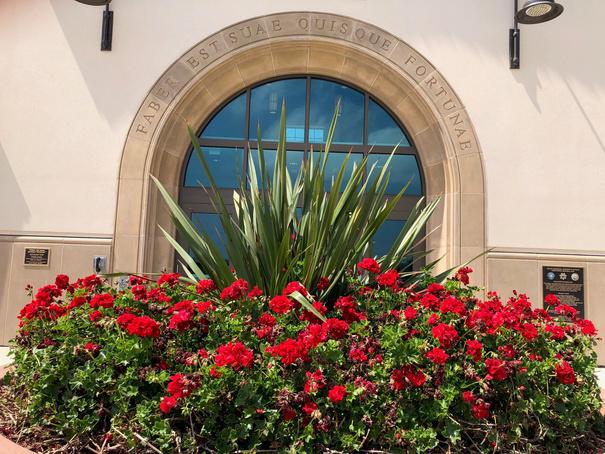









public safety ealignment COMMUNITYCORRECTIONSPARTNERSHIP FY2024-2026REALIGNMENTPLAN www.sbprobation.org
FY2024-2025REALIGNMENTBUDGET
COUNTYOFSANTABARBARA
1 Table of Contents INTRODUCTION…………………………………………………………………………………………………………………………….…4 I. LOCAL PLANNING & OVERSIGHT……………………………………………………………....……………………….6 EXECUTIVE COMMITTEE OF THE COMMUNITY CORRECTIONS PARTNERSHIP (CCP)….…. 6 COMMUNITY CORRECTIONS PARTNERSHIP AT LARGE MEMBERS (CCP)……………….…….. 6 COMMUNITY CORRECTIONS PARTNERSHIP WORKGROUP…………………………………………….6 II. GOALS, OBJECTIVES, & OUTCOMES………………………………………………..………………………………….7 III. POPULATION ……………………………………………………………………………………………………………………..16 IV. NEW PROGRAMS………………………………………………………………………….…………………..………………. 18 RE-ENTRY, EARLY ACCESS, AND DIVERSION FOR YOU (READY) ………………………...……….… 18 RACIAL JUSTICE ACT (RJA) ATTORNEY …………………………………………………………………………. 19 DEPUTY DISTRICT ATTORNEY FOR CASE MANAGEMENT SYSTEM………………………………... 20 VICTIM WITNESS PROGRAM ASSISTANT FOR DV CASELOADS………………………………………. 20 PRETRIAL INTAKE OFFICERS ………………………………………………………………………………………… 21 DIVERSION DIRECTOR …………………………………………………………………………………………………. 21 HOLISTIC DEFENSE MANAGER …………………………………………………………………………………….. 22 TRANSPORTATION UPGRADES……………………………………………………………………………..……... 22 MENTAL HEALTH PARALEGALS ……………………………………………………………………………….…… 23 JUSTICE-INVOLVED BED EXPANSION …………………………………………………………………………… 23 SECURE TREATMENT BEDS ………………………………………………………………………………………….. 24 COMMUNITY ENGAGEMENT ………………………………………………………………………………………. 24 V. PROGRAM STRATEGIES ………………………………………………………………………………….………………….25 FAMILIAR FACES ……………………………………………………………………………………………………….… 25 NEIGHBORHOOD RESTORATIVE JUSTICE PROGRAM …………………………………………………… 26 JAIL CUSTODY ……………………………………………………………………………………………………………... 28 SHERIFF’S TREATMENT PROGRAM (STP) …………………………………………………………………….. 29 ONSITE SOLAR TRAINING PROGRAM…………………………………………………………………….……… 30 FREEDOM TO CHOOSE …………………………………………………………………………………………..…… 31 PRETRIAL ASSESSMENT ………………………………………………………………………………………………..32 PRETRIAL SUPERVISED RELEASE PROGRAM ………………………………………………………………… 33 PRETRIAL SERVICE NAVIGATORS …………………………………………………………………………………. 34 DETENTION ALTERNATIVES …………………………………………………………………………………………. 36 RE-ENTRY COORDINATOR ……………………….……………………………………………………………. 36 VICTIM SERVICES ……………………………………………………………………………………………………….…37 EARLY INTERVENTION SERVICES …………………………………………………………………………….37 DISCHARGE PLANNING ……………………………………………………………………………………………….. 38 PROBATION REPORT AND RESOURCE CENTERS (PRRC) ………………………………………………. 39 HOLISTIC DEFENSE …………………………………………………………………………………………………….… 41 BEHAVIORAL HEALTH SERVICES …………………………………………………………………………………...42
4.
5.

2 CO-RESPONSE TEAMS …………………………………………………………………………………………… 44 COMMUNITY SUPERVISION & CASE MANAGEMENT …………………………………………………… 44 HOUSING ………………………………………………………………………………………………….………………….45 SUPPORTIVE & TRANSITIONAL HOUSING…………………………………………………………….….45 SOBER LIVING HOMES……………………………………………………………………………………….….. 46 WITHDRAWAL MANAGEMENT.……………………………………………………………………….……. 46 BRICK AND MORTAR HOUSING DEVELOPMENT …………………………………………….……... 47 HOUSING SPECIALIST ………………………………………………………………….………………….…….. 47 COLLABORATIVE COURTS ………………………………………………………………………………………….… 47 PUBLIC DEFENDER’S OFFICE COLLABORATIVE COURT ATTORNEY …………………………..48 DISTRICT ATTORNEY’S OFFICE COLLABORATIVE COURT ATTORNEY ………………………. 48 COMPLIANCE RESPONSE TEAMS (CRT) ……………………………………………………………………….. 49 REGIONAL REALIGNMENT RESPONSE FUND ……………………………………………………………….. 50 ADMINISTRATION ……………………………………………………………………………………………….………. 50 DATA COLLECTION & EVALUATION …………………………………………………………………………….. 50 SANTA BARBARA COUNTY DATA SHARING COMMITTEE ………………………………………..51 RECIDIVISM ………………………………………………………………………………………………..………….51 VI. CLOSING ……………………………………………………………………………………………………………………………. 53 VII. SPENDING PLAN 54 1. FY 24-25 Public Safety Realignment Act Budget .............................................................. 55 2. Public Safety Realignment Act (AB109) Restricted Fund Balance .................................... 60
AB109 Restricted Fund Balance (Reserves) Programmatic………………...............................61
3.
Public Safety Realignment Act (AB109) Five Year Use/Source of Funds Trend Summary.62
Public Safety Realignment Act (AB109) Five Year Use/Source of Funds Trend (Detail) ... 64 VIII. ATTACHMENTS …………………………………………………………………………………………………………………..67 Attachment #1: Realignment Operational Impact Reports ……………………………………….…………68 Attachment #2: Probation Report & Resource Center Programming Menu ………………………..75
#3: Sheriff’s Treatment Program (STP) Curriculum Guide …………………………….….79
Attachment
3 Figures Figure 1: PRCS and PSS Race/Ethnicity …..…………………………………………………………………………..16 Figure 2: Population Gender ……………………………………………………………………………………………… 16 Figure 3: PRCS and PSS Populations ........................................................................................16 Figure 4: Population Risk ........................................................................................................ 17 Figure 5: Supervised Probation Population ……………...............................................................17 Figure 6: Neighborhood Restorative Justice Program Referrals ……………………………....…..…….26 Figure 7: NRJP Program Outcomes ......................................................................................... 27 Figure 8: Pretrial Assessment Reports ....................................................................................32 Figure 9: Pretrial Supervision Outcomes ………………………………………………….…..…………………... 33 Figure 10: Individuals on Supervised Pretrial Release: FY 19-23............................................. 34 Figure 11: Clients Served by Department of Behavioral Wellness ……………………………………….43 Figure 12: Collaborative Courts Case by Court Type …………………………………….…………………… 48 Figure 13: Compliance Response Teams (CRT) ....................................................................... 49 Figure 14: PRCS Recidivism 3 Years from Start of Supervision ............................................... 52 Figure 15: PSS Recidivism 3 Years from Start of Supervision ..................................................52

INTRODUCTION
Welcome to the Santa Barbara County Public Safety Realignment Plan! Since 2011, the Santa Barbara County Probation Department has compiled and circulated a comprehensive plan, following months of preparation and discussion with the members of the Community Corrections Partnership (CCP), stakeholders, and members of the community. Each year, the developed plan is presented to the Executive Committee and General Membership of the CCP and voted on for approval prior to submission and presentation to the Board of Supervisors (BOS). As required by statute, the annual plan and recommended programs are consistent with local needs and resources as applied to the Realigned population. In August of 2022, the CCP adopted a two-year cycle for preparation of a full Realignment Plan and last year an addendum was completed; therefore, this year includes a complete plan.
The Public Safety Realignment Act (Assembly Bill 109) was passed on October 1, 2011, with the objective to address overcrowding in California’s prisons and help alleviate the State’s financial crisis. Additionally, this Act expanded the role of the Santa Barbara CCP, which was established as part of the California Community Corrections Performance Incentives Act of 2009 (Senate Bill 678), and created the seven (7) member Executive Committee. The Act transferred the responsibility for specific inmates and parolees from the California Department of Corrections and Rehabilitation (CDCR) to counties. With the shift of the responsibility to the Counties and local communities, it was imperative that the CCP create and maintain specific goals and objectives to best serve this population.

Within this plan, the five (5) CCP goals are outlined and remain the pillars that guide the ongoing work and funding allocations. The CCP remains committed to the use of evidence based and promising practices to carry out the CCP goals, with a balanced approach on how the associated funding is allocated. To ensure the CCP funded programs meet the ongoing needs of the local population and address the CCP goals, participating Departments are required to provide annual presentations that include a review of the overall objectives, previous year’s performance, a detailed recommended budget, and any proposed reductions or expansions. The presentations provide an opportunity for discussion from collaborative agencies, community members and other stakeholders to review how programs and operations support the Realignment Plan goals and objectives. While the membership meets in person, a virtual component has been continued during this past year to provide a more convenient platform for the community to participate and engage in discussions on the direction of the coming year.
4
In summary, the CCP continued to review new program proposals, recidivism data, programmatic updates, new legislation, grant opportunities, pilot programs and current trends in the justice system over the past year. Within the next year, the CCP has emphasized the need for even more robust data elements and performance measure review to ensure the ongoing programs and expansions are realizing their intended outcomes. The CCP continues to support the concepts of justice reinvestment and values the collaborative efforts between Departments and community-based organizations (CBO). This plan represents the CCPs approach to public safety, using a client centered focus with emphasis on expanding diversion options, improving and streamlining re-entry coordination, adapting to the growing pretrial population, providing effective treatment interventions, and ensuring victims are supported. The changes that have been made for the coming year are outlined within the plan and are focused on addressing the needs of the justice-involved individuals, reducing recidivism, and having a positive impact on those served.


5

I. LOCAL PLANNING & OVERSIGHT
Each year, the CCP develops a plan for the Public Safety Realignment Act (Assembly Bill 109) and the Executive Committee of the Community Corrections Partnership (ECCCP) votes to approve the annual spending plan submission to the BOS. As required by statue, the annual plan and recommended programs are to be consistent with local needs and resources as applied to the Realigned population.
EXECUTIVE COMMITTEE OF THE COMMUNITY CORRECTIONS PARTNERSHIP
Holly Benton, Chief Probation Officer, (Chair) Probation Department
Bill Brown, Sheriff/Coroner, Santa Barbara Sheriff’s Office
Tracy Macuga, Public Defender, Public Defender’s Office
Toni Navarro, Director, Department of Behavioral Wellness
Darrel Parker, Court Executive Officer, Superior Court
John Savrnoch, District Attorney, Office of the District Attorney
Marc Schneider, Chief of Police, Santa Maria Police Department
COMMUNITY CORRECTIONS PARTNERSHIP AT LARGE MEMBERS
Sylvia Barnard, Executive Director, Good Samaritan Shelter
Michael Heck, Director, Community Solutions Inc. (CSI)
Daniel Nielson, Director, Department of Social Services
Susan Salcido, Ed.D., Superintendent County Education Office
Luis Servin, Executive Director, Workforce Development Board
Das Williams, 1st District Supervisor, County Board of Supervisors
COMMUNITY CORRECTIONS PARTNERSHIP (CCP) WORKGROUP
Michael Cash, Chief of Police, Guadalupe Police Department
Spencer Cross (Chair), Deputy Chief Probation Officer, Probation Department
Kelly Duncan, Assistant District Attorney, Office of District Attorney
Darcel Elliot, 1st District Representative, County Board of Supervisors
Tanja Heitman, Assistant County Executive Officer, County of Santa Barbara
La Mer Kyle-Griffiths, Assistant Public Defender, Office of the Public Defender
Toni Navarro, Director, Department of Behavioral Wellness
Darrel Parker, Court Executive Officer, Superior Court
Luis Servin, Executive Director, Workforce Development Board
Vincent Wasilewski, Chief Custody Deputy, Santa Barbara Sheriff’s Office
6
II. GOALS, OBJECTIVES, & OUTCOMES
Public Safety Realignment places significant responsibility on the local jurisdiction and presents numerous challenges; however, by offering considerable flexibility, it also presents opportunities. The local CCP is committed to mitigating challenges and seizing opportunities to improve the local criminal justice system. To guide the local efforts and provide focus to the designated resources, the following goals, objectives, and outcomes have been developed. The CCP continues to refine its objectives to ensure services, programs, and strategies are aligned with the overarching goals, and that these goals continue to guide the Realignment work of partner agencies and community-based organizations working with the Realigned and pretrial populations. While this Realignment Plan is for fiscal years 2024 through 2026, the goals, objectives and outcomes will be reviewed annually.


7

GOAL1
Enhance public safety by reducing recidivism1
Reducing recidivism is the primary focus of Santa Barbara County’s Realignment efforts. Strategies for affecting the drivers of criminal behavior require the use of evidence-based programs delivered to model fidelity. Not only has the CCP endorsed the utilization of programs proven to reduce recidivism, it has leveraged its work with “Results First” to guide resource allocation decisions.
OBJECTIVES
Deliver evidence-based programming that is data-driven and matched to Realigned clients’ risks and needs.
FY 23-24
PROJECTED OUTCOME
As of December 31, 2023, 28% of Realigned clients successfully discharged from a Cognitive Behavioral Therapy (CBT) intervention such as Reasoning and Rehabilitation (R&R), Moral Reconation Therapy (MRT), or Seeking Safety showed improvement in four (4) of the six (6) domains of the Texas Christian University Criminal Thinking Scales (TCU CTS) between a pre and post-test, not realizing the 50% goal for this objective. Upon analysis, it was determined domains measuring client empathy and management of anger were least likely to display change.
FY 24-25
PROPOSED OUTCOMES
Informed by the pre-post findings of the TCU CTS, contract for no less than one (1) CBT anger management intervention to address client feelings, resulting behaviors and strategies to control. No less than 50% of clients discharged successfully after completing the CBT intervention for anger management will show improvement between the pre/post TCU CTS measuring client empathy and management of anger.
Expand the use of best practices for evidencebased sentencing and adjudication that utilizes Realigned clients’ specific risk, needs, and responsivity measures.
The extent to which COVID-19 influenced reoffending and crime rates has yet to be determined. With this acknowledged, Santa Barbara County Superior Court and Probation records indicate the percentage of Realigned clients with a new felony or misdemeanor conviction three (3) years from the start of supervision or release from custody as:
41.8% for Post Release Community Supervision (PRCS) clients. This exceeds the FY 23-24 goal of 42.6%.
45.1% for Post Sentence Supervision (PSS) clients. This is an increase from the FY 23-24 goal of 40%.
(Refer to page 52 for recidivism trend since 2011)
Percentage of clients with a new felony or misdemeanor conviction 3 years from the start of supervision or release from custody will not exceed 41.8% for PRCS clients and 40% for PSS clients.
1 Defined as a new felony or misdemeanor conviction 3 years from the start of supervision or release from custody
8
OBJECTIVES
Support professional training to advance systemwide knowledge of evidence-based practices in the criminal justice field.
GOAL1
Continued from previous page
FY 23-24
PROJECTED OUTCOME
It is projected that as of June 30, 2023, no less than twenty-one (21) trainings related to evidence-based practices and/or interventions will be provided to staff exceeding the goal of ten (10) for this objective.
FY 24-25 PROPOSED OUTCOMES
Ensure no less than five (5) targeted trainings are provided to staff delivering community interventions to high utilizers in the Familiar Faces program. Trainings will include an evidencebased communication program such as LEAP® focused on creating relationships with clients with the goal of helping them accept treatment; outreach and engagement; and care coordination for field-based mental health and outreach providers.

9

GOAL2
Enhance the use of alternative detentions (pre- and post-sentence) for appropriate justice-involved individuals.
The CCP is focused on reducing the reliance on incarceration through the utilization of alternative sentencing options for appropriate justice-involved individuals. Research-based assessment instruments are used to assure the safety of the community and reduce unnecessary detention for eligible individuals including those who are awaiting the trial and those already sentenced.
OBJECTIVES
Utilize evidencebased assessment tools for pretrial and post-sentence jail release decisions.
From July 1, 2022, to June 30, 2023, 22% of defendants failed to appear during their pretrial monitoring period, not meeting the 20% goal for this objective. Barriers of this population identified to date include transiency, substance abuse, and mental illness.
Complete the collaborative review and evaluation of current override procedures to ensure local supervision practices are aligned with assessed risk and individuals are supervised at the appropriate level.
Strive to maximize jail capacity for highest-risk clients and identify those who can be safely released.
As of December 31, 2023, 58% of inmates held in the jail over two (2) weeks had either the Initial Screen Tool (IST) or COMPAS assessment completed, not meeting the FY 23-24 goal of 80%.
Additionally, of the total housed jail population with either the IST or COMPAS completed, 13% were assessed as low-risk2 to re-offend, not meeting the 9% goal for this objective.
Increase the number of enrolled individuals on alternative sentencing by 50% from 56 to 84 individuals by October 2024 through the examination of eligibility criteria to determine where opportunities exist to allow additional individuals to enroll and be supervised safely in the community without negatively effecting overall community safety and security.
80% of inmates held in the jail over two (2) weeks will have either an IST or COMPAS completed. Additionally, no more than 9% of the total housed jail population will be assessed as low-risk to reoffend.
2 Defined as scoring between 1-3 on the IST or between 1-5 on the risk of general recidivism and risk of violence scale on the COMPAS
10
FY
PROJECTED OUTCOME FY
PROPOSED OUTCOMES
23-24
24-25
OBJECTIVES
Expand the diversion of individuals from the justice system.
GOAL2
Continued from previous page
FY 23-24
PROJECTED OUTCOME
From July 1, 2023, to December 31, 2023, a total of 99 individuals enrolled in the Neighborhood Restorative Justice Program (NRJP). It is projected that by June 30, 2024, the NRJP will enroll approximately 198 individuals, exceeding the goal of 100 for this objective.
FY 24-25
PROPOSED OUTCOMES
Refer no less than 200 individuals from the justice system to the NRJP.
Increase the percentage of individuals completing NRJP from 30% to 40%.
Execute a contract for a process evaluation to examine diversion options across Santa Barbara County including population served by each, suitability and eligibility criteria, as well as indicators of net-widening.

11

GOAL3
Provide for successful and equitable re-entry of justice-involved individuals back into the community.
The CCP is committed to coordinating and providing services to prepare justice-involved individuals for the successful return to their community after a period of incarceration. Strategies include providing needed rehabilitative services, removing barriers to housing, as well as capturing community input on program development and other justice system reform efforts.
OBJECTIVES FY 23-24
Provide services and treatment in partnership with existing community providers.
Facilitate access to sober living and transitional housing, as well as long-term supportive housing.
Promote a shared safety approach in conjunction with community partnerships and engagement.
Number of clients evaluated for referral through the Community Defender Division (CDD) to services including shelter, housing, drug treatment, mental health treatment, and vocational services.
Between July 1, 2023, and December 31, 2023, 24% or 6 of 25 individuals enrolled in Goodwill services secured employment, not meeting the FY 23-24 goal of 50%.
From July 1, 2023, through December 31, 2023, 53% or 39 of 73 clients exiting supportive housing secured stable housing, not meeting the goal of 56% for this objective.
On October 6, 2023, the Community Corrections Partnership approved the Valuing Voices community outreach initiative thereby meeting the goal for this objective. Valuing Voices is a qualitative study of individuals’ experiences to identify opportunities to improve the delivery of services for individuals returning to their communities.
Ensure no less than 50% of individuals enrolled in employment services secure employment.
No less than 58% of clients exiting supportive housing will secure a positive housing destination.3
Execute a contract with Community Solutions, Incorporated (CSI) for the qualitative Valuing Voices study and receive draft data collection and recording methods as well as survey, focus group and interview questions for workgroup review.
From July 1, 2023, to December 31, 2023, 43% of clients experiencing homelessness at first contact were connected to housing services (74 of 172), not meeting the goal of 68%.
No less than 50% of clients served by the CDD, will achieve sustained stable housing or consistent employment.4
3 Positive housing is defined as a regular nighttime residence that is not a temporary shelter or other place not designed for sleeping.
4 Consistent employment defined as uninterrupted work over no less than a period of 3 months.
12
PROJECTED OUTCOME FY 24-25 PROPOSED OUTCOMES
GOAL4
Coordinate efforts to eliminate duplication, enhance efficiencies, and promote best practices.
Working collaboratively, the CCP is able to address emerging issues to support the Realigned population and promote community safety. These efforts have included data integration across systems, the evaluation of Public Safety Realignment practices and programs, and fidelity reviews of delivered evidence-based programs.
OBJECTIVES
Ensure fidelity to the research-based models for funded programs.
Evaluate adherence to evidence-based strategies.
It is projected that by June 30, 2024, no less than 90% of funded evidence-based programs will have completed curriculum specific fidelity reviews, meeting the outcome for this objective.
An action plan to systematically address no less than four (4) of the identified areas of the University of Cincinnati Corrections Institute (UCCI) report to increase adherence to evidence-based practices in the adult Probation division was initiated and strategies to achieve are in progress, meeting the outcome for this objective.
To assess quality and monitor program fidelity-how closely a program adheres to its researchbased design-ensure no less than 90% of funded evidence-based programs have completed curriculum specific fidelity reviews.
80% of clients who engage with the Holistic Re-entry, Early Access, and Diversion (READY) program will enroll in at least one evidence-based program with a community-based organization.
Collaborate with justice partners for information sharing and coordination of efforts around best practices.
The Probation Department temporarily reassigned a manager as the interim MultiAgency Assessment, Case Planning and ReEntry Coordinator (Re-entry Coordinator) until the recruitment and hiring of a permanent non-sworn staff is completed. The Re-entry Coordinator is tasked with ensuring diversionary options are maximized, individuals entering the jail receive multi-agency assessments and case planning, and any individuals exiting the jail are provided a robust discharge plan and a warm handoff as appropriate.
Map the discharge planning workflow to include a delineation of roles and responsibilities of the various entities involved in discharge planning and implement a pilot project to provide enhanced discharge planning services to a subset of the following:
Medication Assisted Treatment (MAT) patients
Individuals discharged from Specialized Mental Health Units
Patients with chronic care needs, and those identified with serious mental health needs.
13
FY
PROJECTED OUTCOME FY 24-25 PROPOSED OUTCOMES
23-24
OBJECTIVES
Capture and integrate data necessary to measure outcomes.
GOAL4
Continued from previous page
FY 23-24 PROJECTED OUTCOME
In FY 23-24, Santa Barbara County launched a cross-department initiative focused on serving high-need individuals who are reluctant to engage in services, through a multi-disciplinary street outreach team. The Familiar Faces Team (FFT) conducts daily outreach and engagement of clients to supportive services within the City of Santa Barbara and surrounding areas. The design and implementation of this multi-agency model to support a community mental health outreach program in Santa Barbara County meets the outcome for this objective.

FY 24-25 PROPOSED OUTCOMES
Execute necessary minimum data exchange with BWell to generate the MNI key as outlined in the Santa Barbara County Interagency MOU regarding the County’s Integrated Information System (CIIS) for evaluation and outcome reporting of the FFT initiative.

14
GOAL5
Support a systemic approach to studying and addressing racial and ethnic disparities in the justice system
The CCP is committed to understanding the extent to which racial and ethnic disparities exist within the criminal justice system. The partnership maintains its commitment to ensuring all justice-involved individuals are treated with dignity, respect, and humanity. In FY 24-25, the partnership will focus on expanding its understanding and impact of racial and ethnic disparities in the justice system and addressing and implementing processes to assist in reducing disproportionality.
Partner with local justice partners to educate staff and stakeholders, and strategize approaches to address any racial and ethnic disparities in the local justice system.
Use county-specific findings on racial and ethnic disparities to inform decision-making.
In FY 23-24, a subcommittee of the CCP Workgroup met to review approaches and tools that could guide pro-equity policy and decisionmaking, planning, operations, and services, to advance equity and social justice of the justice partners within Santa Barbara County. Discussions have explored the use of an equity impact review tool and hiring of a racial equity consultant to support Goal 5 initiatives.
Design and implement five trainings for defense attorneys and/or system partners throughout Santa Barbara County including topics such as identifying racial bias, deciphering coded language, best practices for discovery review, and analyzing data.
Develop and implement a race equity tool to integrate into the CCP decision-making process. This will include designing and piloting the tool, as well as creating a presentation to educate and engage the CCP on its use and implementation strategies.
Solicit input from justice involved clients and/or victims on the challenges faced and receive feedback on treatment within the criminal justice system to ensure all are treated with dignity, respect and humanity.
The Probation Department interviewed 35 individuals at its Probation Report and Resource Centers (PRRCs) to gain deeper insight into the identified service barriers of transportation, housing, and qualification for services, meeting the outcome for this objective. Feedback will be analyzed to identify tangible actions to improve access to services.
As part of Community Solutions, Incorporated (CSI) multi-modal qualitative Valuing Voices study, initiate data collection to gather information highlighting strengths, services gaps, racial/ethnic disparities, and recommendations by means of interviews, focus groups, and community surveys to justiceinvolved clients and/or victims, their families, and those who work with them.
15
OBJECTIVES FY 23-24 PROJECTED OUTCOME FY 24-25 PROPOSED OUTCOMES

III. POPULATION
The implementation of Public Safety Realignment created two (2) additional populations supervised by the Probation Department, which includes (Figure 1-3):
Post Release Community Supervision (PRCS). These are individuals released from prison to local supervision after serving a felony commitment for a non-violent, non-serious and non-high-risk sex offense.
Mandatory Supervision, also referred to locally as Post Sentence Supervision (PSS). These are individuals sentenced pursuant to 1170(h)(5)(B) PC who qualify to serve their prison sentences locally in the County jail after being convicted of a non-serious, non-violent offense. Additionally, these individuals are not registered sex offenders and do not have a prior “strike” (serious and/or violent felony). The law allows for two (2) types of sentences; a straight commitment to County jail pursuant to 1170(h)(5)(A) PC or a split sentence 1170(h)(5)(B) PC which includes a period of time in jail followed by a period on mandatory supervision by Probation.

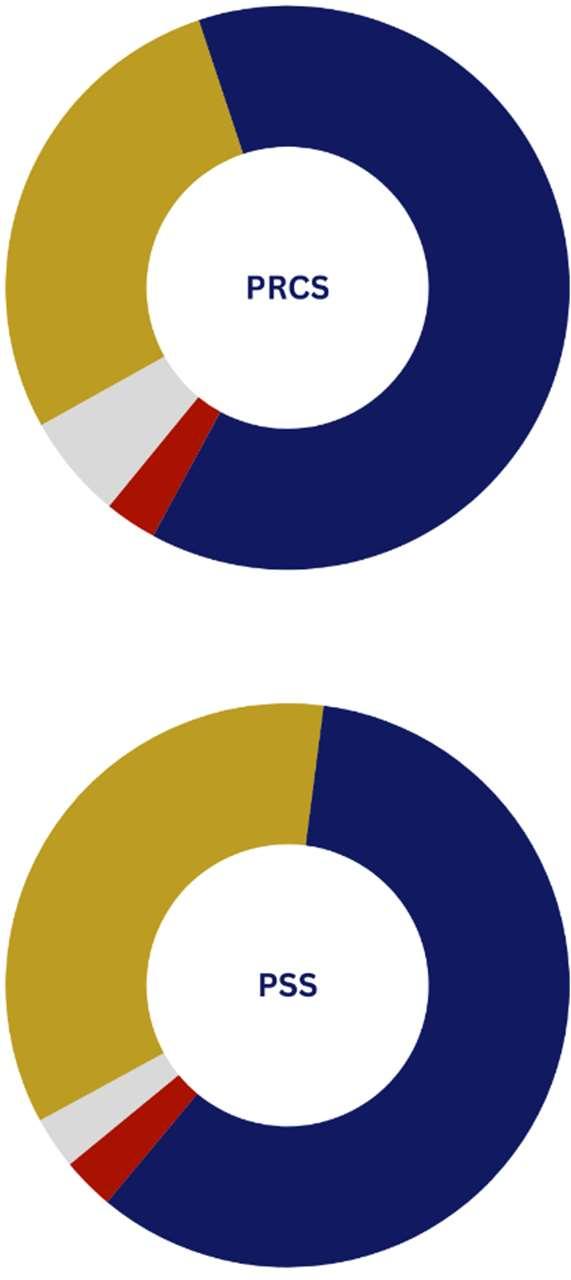
16
302273263252249252257263272269260266261266252247255260254248238243251255260277273272267280289 131 116113112112113118112118118118121117117125132132138140146143145144145148149152156156159153 433 389376364361365375375390387378387378383377379387398394394381388395400408 426425428423439442 0 50 100 150 200 250 300 350 400 450 500 PRCSPSSTotal Figure3:PRCSandPSSPopulations Figure 1: PRCS and PSS Race/Ethnicity Other 3% Black 6% White 28% Hispanic 63% Hispanic 59% White 35% Black 3% Other 3%
In comparison to the total number of individuals supervised by Probation, Realigned clients represent only 17% of the total supervised population in the County (Figure 5). However, Realigned clients are more likely to assess as high-risk to reoffend or reoffend violently as compared to those on standard probation supervision (87% for PRCS clients and 71% for PSS as compared to 34% for those on standard probation supervision) (Figure 4).




17
Figure 5: Supervised Probation Population
Figure 4: Population Risk

IV. NEW PROGRAMS
The CCP remains committed to exploring innovative programs, services, and solutions to address the needs of the County’s Realigned population including those in custody, under supervision, on pretrial, or requiring re-entry services. One-time funding offers community partners a unique opportunity to explore innovative ideas, programs and services. The CCP has approved the following for one-time funding:
RE-ENTRY, EARLY ACCESS, AND DIVERSION FOR YOU (READY)
The Public Defender’s Office was awarded $715,000, over the period of three years (FYs 23-24, 24-25, 25-26) through the Board of State and Community Corrections (BSCC) through the Edward Byrne Memorial Justice Assistance Grant Program (JAG) which provides funding for the Re-entry, Early Access, and Diversion for You (READY) program. The CCP funded an additional $1,266,857 over the same period to supplement the services to clients with mental health illness, substance use issues, who are unhoused, and are the most vulnerable in our community.
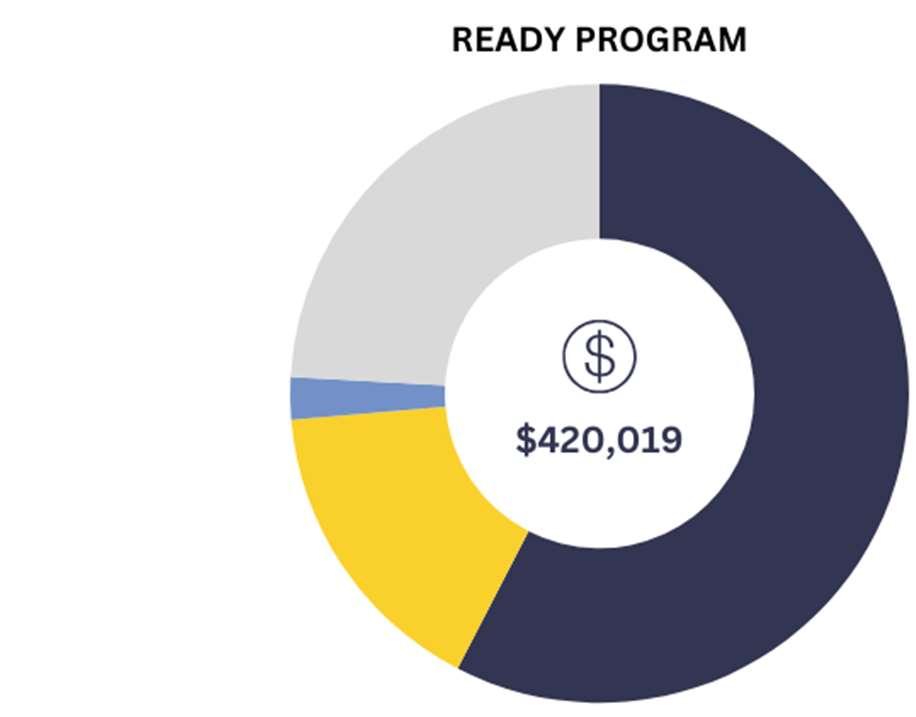


The READY project weaves together resources from the Public Defender, Probation Department, Good Samaritan Shelter, and local community-based organizations that specialize in areas such as life skills, job readiness, medical care, and other skills. The goal of READY is to provide an assessment of needs, connection to services, and representation at the earliest stage of a criminal case in addition to reducing the harm of pretrial incarceration for those well suited to be released from jail and diverted from the criminal legal system. The READY program was implemented to swiftly meet the needs of individuals booked into the jail on misdemeanor charges. The READY team assesses the individual’s needs, community ties, employment, and family situation within the first 48 hours of incarceration. This stage is critical as information gathered at this time has the potential to positively impact the outcomes at the arraignment hearing. The highest rate (27%) of repeated return to jail offenses includes three common misdemeanor substance-related offenses: 1) disorderly conduct under the influence of drugs or alcohol; 2) possession of drug paraphernalia; and 3) under the influence of a controlled substance5. The READY team consists of an attorney to navigate the potential legal outcomes, an investigator to gather records, follow up and verify information from employers, family and friends, and a law office professional to help make sure any information gathered is properly recorded and transmitted. In addition, READY includes peer navigators who assist clients with successful re-entry. This structure allows more robust, meaningful, and early advocacy in the proceedings, often before charges

5 September 2022 Santa Barbara County Criminal Justice Outcomes Under Zero Bail report retrieved from the Santa Barbara County Probation Department website: https://content.civicplus.com/api/assets/9529fdbe-34f3-4b61-b2fb84c528b3667e?cache=1800
18
MentalHealthNavigator (1.0FTE) $101,390 AdminCosts $9,280 InvestigativeTech (0.75FTE) $67,500 DeputyPublicDefender (1.0FTE) $241,849READYPROGRAM(PD)
have been filed. The READY team will also communicate with clients’ families, conduct time-sensitive investigations, and speak with the prosecution about the case. Intervention at this early stage will assist advocates to provide clearer information to the court concerning release which, in turn, improves public safety.
RACIAL JUSTICE ACT (RJA) ATTORNEY
Assembly Bill 2542 took effect on January 1, 2021. Known as the California Racial Justice Act (RJA), the legislation allows the defense to challenge criminal charges or sentences or vacate a conviction by demonstrating that racial discrimination or bias, direct or implicit, played a role in the prosecution.
A critical feature of AB 2542 is that it recognizes the difficulty of proving discrimination or bias without access to the data necessary to support the claim. The RJA legislation provides a mechanism for the defense to gain access to the needed information. The defense may seek disclosure from any source— the local district attorney’s office, law enforcement agencies, county probation department, the Department of Justice, the California Department of Corrections and Rehabilitation, and any others that may possess such information.



The Public Defender’s Office and the District Attorney’s Office are committed to supporting a systemic approach to studying and addressing racial and ethnic disparities in the criminal justice system. The CCP approved one-time funding for the period of three years for the Public Defender’s Office to hire an RJA Attorney. The Public Defender’s Office has hired an attorney with over 20 years of experience in trial work with a focus on racial justice. This RJA attorney will review practices in different counties to develop a more effective approach for individuals facing bias due to race, culture, or national origin. The RJA attorney will collect data from key stakeholders to understand the impacted population, sentencing disparities, and areas vulnerable to bias in the justice system. Additionally, the RJA attorney will provide training to personnel most susceptible to systemic biases to ensure fair decision-making.

19
$7,100
RacialJustice ActAttorney $235,000 3%AdminFee

DEPUTY DISTRICT ATTORNEY FOR CASE MANAGEMENT SYSTEM
The District Attorney’s Office received one-time CCP funding for a Deputy District Attorney (DDA) to oversee the implementation of the new case management system (CMS). This position worked with the selected vendor to complete the software development/architecture phase, and took the lead with officewide trainings.
The DDA took the lead on this project and serve as a subject matter expert to provide an experienced prosecutor's perspective. The DDA provided invaluable insight into how the CMS should work to optimize workflow and comply with statutory requirements for data analysis, and provided important insight and guidance on how the CMS would work with other County partners to promote better workflows and information exchanges.
AdminFees (3%)

VICTIM WITNESS PROGRAM ASSISTANT FOR DV CASELOADS
The District Attorney’s Office received one-time funding over a period of three (3) years for a Victim-Witness (VW) Program Assistant to address the significant increase in the volume of domestic violence cases in North County.The VW Assistance Unit in North County reported a 21% increase in domestic violence (DV) case referrals between 2019-2022. Most notably the increase in referrals involved a high risk of lethality. High lethality is defined as a DV case that is accompanied by strangulation, death threats, weapons, and/or suicidal ideations. The majority of the cases involved situations in which there were children in the home who witnessed the violence.

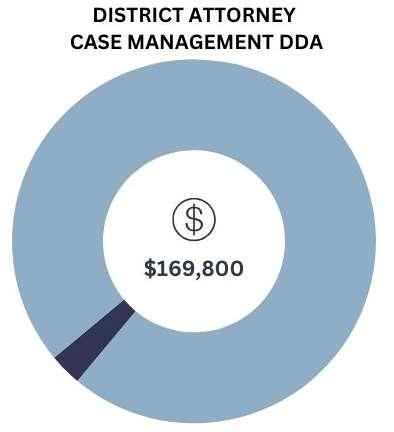
$4,900 DeputyDistrict Attorney (1.0FTE)

$164,900

Victim-Witness Program Assistant (DA)
The role of the victim witness assistant is to provide crucial documentation to the Deputy District Attorneys, Courts, Probation/Pre-Trial Services, and victims of crime. This information plays a vital role in the pre-trial decision-making process, including the determination of criminal protective orders and restitution orders. The information is especially time-sensitive in cases where the accused is in custody, as immediate decisions need to be made that can impact the safety of victims, as well as the efficiency of the criminal justice process, which includes various stakeholders such as the Public Defender, Probation/Pre-Trial Services, and the courts.
20
The objective of this new position is to effectively support victims and proactively respond to the significant increase in North County domestic violence referrals. Having a dedicated DV Advocate allows for early intervention and long-term case management services, safety planning, resource and referral counseling, emergency relocation, and securing of financial assistance to help victims break free from the cycle of violence. Additionally, this position helps the District Attorney's Office uphold constitutionally-mandated victims’ rights and better serve the community.
PRETRIAL INTAKE OFFICERS
For the coming fiscal year, the CCP approved one-time funding of $355,800 for two full-time Deputy Probation Officers who would serve as Pretrial Intake Officers. The addition of Pretrial Intake Officers fills a void where specific staff will be dedicated to greeting pretrial client walk-ins and conducting same day intake appointments, reducing waiting periods when clients report to Probation. Intake officers will be responsible for assessing and referring clients for needed services, as well as preparing cases for assignment to Pretrial Compliance Officers (PTCOs) based on risk. Their dedicated efforts will allow PTCOs who were previously tasked with intake duties to have greater time to conduct field visits, author progress reports, and monitor client adherence to Court orders.
DIVERSION DIRECTOR

For the coming Fiscal Year, the CCP approved one-time funding over two (2) years to add a Deputy District Attorney Senior to serve as the District Attorney’s Diversion Director. The Diversion Director will serve as the District Attorney’s main point of contact for all diversion programs. This position will have several key responsibilities, including the development, implementation and management of diversion programs in collaboration with other criminal justice agencies, community organizations, and service providers. The Diversion Director will also be responsible for creating procedures that identify, assess, and refer individuals suitable for diversion programs. This dedicated staff member will assess the needs of individuals involved in the criminal justice system and tailor interventions to address their specific needs. The Diversion Director will monitor and evaluate the effectiveness of diversion programs, collect data on participant outcomes, and make adjustments to improve program success. This position will ensure that diversion programs comply with applicable laws and work to address legal challenges or concerns. Additionally, the Diversion Director will continue to build partnerships with community organizations, social services, and other stakeholders to ensure a comprehensive and community-centered approach to criminal justice. The Diversion Director will also

21
Diversion Director (1.0 FTE) $270,000 Admin $8,100 Deputy Probation Officer (2.0 FTE) $355,762

provide training to prosecutors, law enforcement, and other relevant personnel on diversion program criteria, goals, and procedures.
HOLISTIC DEFENSE MANAGER
For FY 24-25 through FY 25-26, the CCP approved one-time funding for one (1) Holistic Defense Manager (HDM) to assist the Community Defender Division (CDD) to be more efficient, reach more clients and document those efforts even more granularly allowing the CDD to better track data. The HDM will work with the Public Defender leadership team to develop new programs policies and procedures and ensure their implementation throughout the division. The HDM will help organize, lead, and coach social workers and advocates to deliver innovative approaches to holistic defense. The HDM will develop organizational and programmatic systems to enhance efficiency, efficacy, and effective data collection while adapting to serve more complex clients.



TRANSPORTATION UPGRADES
For FY 24-25, the CCP approved one-time funding to convert a gas car to an electric car and added an additional electric car to be used by CDD staff. The electric vehicles will allow holistic defense staff to cover the county, while maintaining a commitment to a healthy climate.




22
GasCarConversion toElectric $10,000 Additionof ElectricCar $32,000 HolisticDefense ProgramManager(PublicDefender) 1.0FTE $180,000 PublicDefender3%Admin $5,400
MENTAL HEALTH PARALEGALS
For FY 24-25, the CCP approved one-time funding for a period of two-years in the amount of $528,703 for two (2) full-time Legal Office Professional Seniors to serve as Mental Health/Diversion Paralegals. The addition of these positions will improve the Public Defender’s ability to address behavioral health disorders, developmental disabilities, emotional and psychological challenges, as well as to confront systemic barriers preventing clients from accessing services.
MentalHealth/Diversion

Paralegals-(PublicDefender)
2.0FTE
$250,400

JUSTICE-INVOLVED BED EXPANSION
The CCP approved the allocation of $1,228,000 of one-time funding for a residential development project with Good Samaritan Shelters to provide 20 supportive housing beds for justice-involved individuals. The beds will be located within three additional dwelling units (ADU) located at Good Samaritan Shelter’s existing three Clean and Sober Living locations in Santa Maria and the fourth site is located in Lompoc and includes a new build.
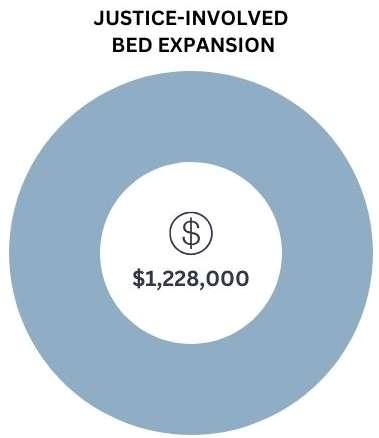


The target population for the project includes individuals who have spent time in jail, prison, youth correctional facilities, are on probation/parole, or are going through criminal Court proceedings without natural supports, including those navigating re-entry, and are ineligible for other types of subsidized housing. Additionally, these individuals may present with some vulnerability such as mental health concerns, but do not qualify for housing options through the Department of Behavioral Wellness, and includes those with significant substance abuse challenges.
23
PublicDefender 3%Admin $7,500
SECURE TREATMENT BEDS
The CCP approved one-time funding to be used for a pilot program to provide four (4) secure treatment beds at the Champion Healing Center within the County for justice involved behavioral health clients who are conserved under the Lanterman Petris Short (LPS) Act or qualify for temporary conservatorship. These beds will be used for clients in County Jail and other local forensic facilities, wherein the Behavioral Health Medical Director has determined they would benefit from placement at a mental health rehabilitation facility. While at the Champion Healing Center, the Justice Involved Conservatees will receive intensive mental health treatment services in order to stabilize and attempt to discharge them to a lower level of care. Champion Healing Center is a Mental Health Rehabilitation Center in Lompoc that is currently operated by Crestwood through a contract with BWell. The objective of this pilot program is to reduce the number of seriously mentally ill inmates in the Santa Barbara County jail.
COMMUNITY ENGAGEMENT
In October of 2023, the CCP approved a one-time allocation request to fund a project through Community Solutions, Incorporated (CSI) named Valuing Voices – Justice Involved Individuals Focus Group Project. The Valuing Voices project aligns with the County’s Public Safety Realignment Plan Goals to support a systemic approach to studying and addressing racial and ethnic disparities in the justice system and provide for successful and equitable re-entry of justice-involved individuals back into the community. Specifically, CSI’s proposed project satisfies the objective of this goal to solicit input from justice-involved clients in a comprehensive and culturally sensitive manner.



To complete the project, CSI will complete a multi-modal qualitative study in a culturally sensitive manner, identifying themes and offering findings and recommendations to reduce racial and/or ethnic disparities in Santa Barbara County. CSI will conduct interviews, focus groups, and surveys throughout Santa Barbara County, encompassing locations such as Santa Maria, Lompoc, Guadalupe, Santa Ynez Valley, Santa Barbara and Carpinteria. These interactions will include individuals with past or present lived experience, their families, and the professionals working alongside them. CSI will collect and analyze the data and provide a final report to the CCP highlighting strengths, services gaps, racial and ethnic disparities, along with recommendations to improve the delivery of services for individuals returning to their communities.

24
BWell Champion Healing Center
CSI Valuing Voices (Probation)
V. PROGRAM STRATEGIES
FAMILIAR FACES6
The Familiar Faces Team consists of a Supervising Probation Officer, Deputy Probation Officer, Public Defender Senior Social Worker, Behavioral Wellness Recovery Assistant, Behavioral Wellness Practitioner, and a Behavioral Wellness Case Worker, all of whom work collaboratively to engage and assist high utilizers of the county jail, individuals who generate a significant amount of law enforcement calls for service, high utilizers of emergency hospital services, and/or those who are frequently placed on psychiatric holds as they have been found to be a danger to themselves or others, or gravely disabled.









The mission of the Familiar Faces Team is to conduct daily outreach and engagement to facilitate the expedited identification, assessment, and linkage of Familiar Faces clients to supportive services within the City of Santa Barbara and surrounding areas. This includes building rapport and relationships based on trust, with the goal of implementing coordinated intervention plans for the priority population. In addition, the team will help broker access to services and community supports through intensive engagement and a “warm hand-off” approach, and ensure that each client is tracked throughout the entire engagement process for continuity of care.

25
6 FY 24-25 One-Time Allocation DeputyProbationOfficer $172,800 RecoveryAssistant BWell $101,000 CaseWorker BWell $128,000 DeputyProbationOfficer Supervisor $201,600 PractitionerI-BWell $151,500 Advocate/SocialWorkers PublicDefender $134,800 ProbationManager $32,900 AvailableFamiliarFaces ProgramFunding $181,065 VehiclePurchase6 $100,000

NEIGHBORHOOD RESTORATIVE JUSTICE PROGRAM
The Santa Barbara County District Attorney’s Office, in partnership with the Second District Supervisor’s Office, implemented a Neighborhood Restorative Justice Program (NRJP) pilot beginning in 2021 (previously referred to as Neighborhood Court). The Neighborhood Restorative Justice pilot program’s robust internal and external framework paved the way for the expansion throughout South County, which began in July 2023. From June 1, 2022, to December 31, 2023, the NJRP received 317 referrals. (Figure 6) NRJP is a restorative justice-based pre-filing diversion program for certain misdemeanor offenses and infractions. Through this program, a person who commits a qualifying offense appears before a panel of trained community volunteers to discuss the offense that took place, the impact of the offense on the community, and actions that the individual can take to make amends with the community and prevent future offenses from taking place. After meeting with NRJP volunteers, the participant completes the agreed-upon accountability actions, such as community service, letters of apology, educational opportunities, counseling, etc. Upon the participant’s successful completion of accountability actions, the District Attorney’s Office does not file the charge in court.
FBSMV
FacilitatorTraining& OutreachDistrictAttorney
$18,000

ProgramCoordinatorsDistrictAttorney(2.0FTE)

$283,100
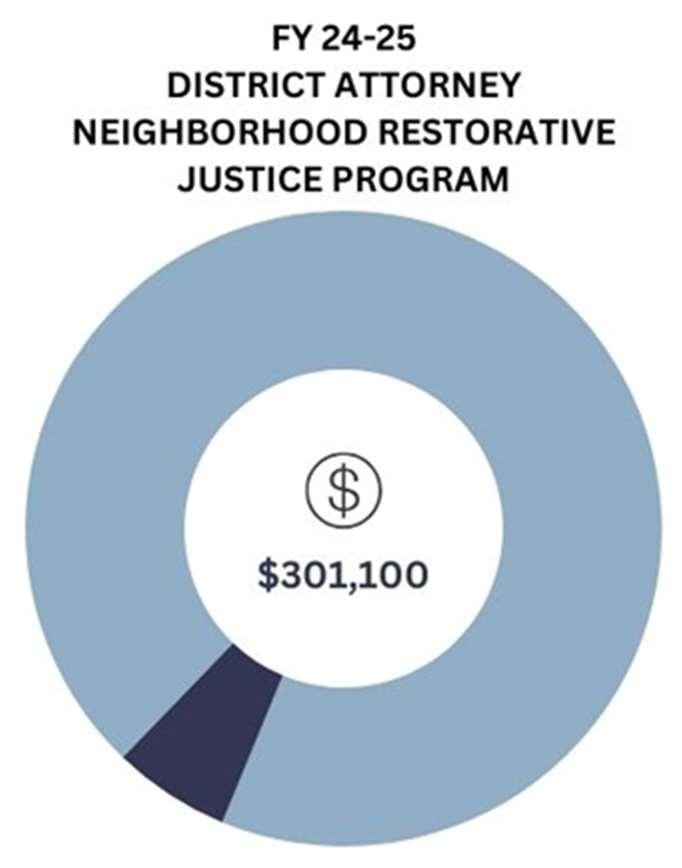

26
Figure 6: Neighborhood Restorative Justice Program Referrals
Benefits of an NRJP include diverting low-level offenses through a restorative justice process that promotes accountability, increased community involvement in advancing public safety, and a reduction in time and money spent on adjudicating low-level offenses in court. The NRJP is based upon a victim-centered approach which can help meet the needs of victims, including the community, and strengthen ties between the individual and others, thereby potentially reducing recidivism for participating individuals and increasing satisfaction with the justice system for participating victims.






The District Attorney's Office received continued support from the CCP during FY 23-24 for a total allocation of $291,700 in ongoing funding and $70,000 in one-time funding, allowing their office to expand the NRJP countywide. This additional funding enabled the District Attorney’s Office to hire an additional program coordinator for North County, contract with Fighting Back Santa Maria Valley (FBSMV) to conduct facilitator training, a media campaign and outreach, and also contract with Dr. Jill Sharkey with the University of California, Santa Barbara as an independent evaluator to utilize key metrics to track the success of the program.
The pilot program's internal and external framework paved the way for the expansion throughout South County. From July 1, 2023, to December 31, 2023, ninety-nine (99) participants enrolled in the NRJP.
The NRJP expansion to North County was implemented in January 2024. Beginning in FY 23-24, the District Attorney’s Office partnered with FBSMV to facilitate trainings for the individuals who have volunteered to serve as NRJP panelists in Santa Barbara, Lompoc, and Santa Maria. Proactive outreach efforts continue to increase volenteer participation.
In 2023, FBSMV launched a media campaign to recruit additional volunteers, particularly for North County. The campaign included the development of video and audio spots, which have aired on local television stations and social media platforms since August 2023. FBSMV is also conducting in-person presentations to civic organizations and other groups to encourage individuals to volunteer for the program. Furthermore, an article about the NRJP was published in the Santa Maria Sun. These outreach events have provided NRJP staff with the opportunity to share their knowledge and experience with the community and encourage individuals to volunteer for the program.

27
Didnotenroll 18% InProgress 17% Pendingresponse toinvitation 28% Failedtocompleteprogram 3% CompletedProgram 30% Declinedenrollment atpre-conference 4%
Figure 7: NRJP Program Outcomes

JAIL CUSTODY
Realignment funds are directed to supplement jail resources as a means of ensuring that justiceinvolved individuals who require a custody setting have a jail bed and to facilitate short flash incarcerations, as needed. Classification requirements mandate the housing of Realigned inmates throughout the jail facilities. The funded jail positions help to ensure there is adequate staff available to address and respond to the needs of the inmates. This required staffing allows for the delivery of supervision during housing, booking and release processes, meals, medical and mental health services, movement related to programming opportunities, and emergency response.
AOPII
$110,400

ParoleeCustody

$275,000
Servicesand

Supplies

$55,000
JailCustodyStaff

$2,356,200
Prior to Realignment, the Santa Barbara Sheriff’s Office (SBSO) received approximately $375,000 annually from the State to help offset a portion of the cost of incarcerating State parolees who were held solely on a parole revocation. Upon implementation of Realignment, the State was no longer required to provide money to house State parole justice-involved individuals in local jails. The Realignment funds provided to the SBSO for jail custody replace this lost State revenue and provide increased funding to house justice-involved individuals that would have previously been confined in State facilities and are now held in the County Jail.
This fiscal year continued to be challenging for the Custody Branch of the SBSO due to continued COVID19 outbreaks, continued work on the Disability Rights California (DRC) remedial plan requirements, and an increase in the average daily population (ADP). The ADP from January 2021 to October 2021 was 624. In early December of 2021, jail booking criteria was modified to allow individuals with outstanding warrants on low level offenses to be booked. The in-custody population increased and led to an average daily population of 723 for the month of December of 2021. The ADP from January 2023 to December 2023 was 833.
The SBSO continues to utilize several court video visitation booths throughout the main jail campus to accommodate the necessary transition to virtual court hearings. This transition has improved efficiency for the courts relative to in-custody defendants. Virtual court hearings, although not without challenges, have proven to be beneficial and have provided additional safety measures as they do not require transporting defendants from the custodial facility to a courtroom. This has ensured incarcerated individuals are able to attend court during COVID-19 outbreaks and other appropriate instances.
28
As the SBSO continues to expand and offer a broad array of programs and services within the jails, the CCP approved the addition of a full-time Administrative Office Professional (AOP) assigned to the main jail in Santa Barbara. This AOP will serve four (4) Correctional Counselors, two (2) Discharge Planners, and the Programs Manager to provide administrative support for the Programs Unit at the main jail. The AOP will have a variety of job functions and duties which will include the tracking of quarterly and annual data for all programs.

SHERIFF’S TREATMENT PROGRAM (STP)
The Santa Barbara County Sheriff’s Treatment Program (STP)7 improves long-term public safety and reduces each participant’s risk of recidivism by teaching effective, evidence-based interpersonal skills that guide the development of a pro-social lifestyle and change the behaviors that lead to criminality and other risky choices. STP is separate from the educational and vocational opportunities available at the jail. As a stand-alone program, STP offers classes and services to all individuals in custody at both facilities with limited pro-social opportunities and experiences. Inmates who are at high risk of reoffending are identified for this intensive in-custody program. Curricula includes: Building Healthy Life Skills, Cognitive Behavioral Training, Moral Reconation Therapy, Criminal & Addictive Thinking, Alcohol and Other Drug Education Workbook, Relapse Prevention, Mindfulness, Parenting Skills, Anger Management, and an array of Interactive Journals.


7 STP Curriculum Guide available in Attachment #3 (page 79) of this document
29

During FY 22-23, the Programs Unit recruited and hired staff to fill vacant positions to nearcapacity with four (4) Correctional Counselor positions and one (1)
Discharge Planner position at the North Branch Jail (NBJ), an additional two (2) Correctional Counselor positions, one (1)
Discharge Planner position at the South Branch Jail (SBJ) and one (1)
AOPI
(1.0FTE-SouthBranchJail)
AOPII
$99,300

(1.0FTE-NorthBranchJail)
$92,800
CorrectionalCounselors (3-NorthBranchJail)

$310,200
Curriculum (NorthBranchJail)

CorrectionalCounselors (2-SouthBranchJail)

$245,100
Curriculum (SouthBranchJail)

$25,000

$20,000
AOP dividing time between both facilities. The Programs team worked to ‘unpack’ the traditional 12-week/4-course format to offer more flexible, single-course options in a 6-week format. This allows for the participants to be able to take one (1) or two (2) courses, meeting two (2) days per week. In late May 2023, the first two (2) Behavioral Health Units (BHU) were inaugurated at the NBJ and the main jail, with STP Program facilitators offering the required six (6) hours weekly of structured programming.
SecurityEscort
(2.0FTE-SouthBranchJail)
$359,100

When in-person classes are not possible, the STP program is able to provide correspondence using Interactive Journals and meeting with participants weekly for collection and review of ongoing work. This correspondence program includes curriculums made available via packets that are to be completed over six-week periods, and qualified participants earn milestone credits. During this fiscal year, COVID19 resulted in a decrease in the number of individuals who completed the standard, 12-week intensive STP Program.
ONSITE SOLAR TRAINING PROGRAM

As documented in last year’s Realignment plan addendum, the CCP approved one time funding to partner with GRID Alternatives, a non-profit solar installer and training provider, to provide onsite job training in photovoltaic installation to incarcerated individuals at the NBJ. The hands on training allows individuals to gain the required skills for entry-level solar installation, which includes construction and electrical basics, interpreting and comprehension of National Electric Code and North America Board of Certified Energy Practitioners concepts, and demonstration of industry related Occupational Safety and Health Administration (OSHA) safety training. Prior to the conclusion of the program, participants are evaluated following an observation of installation techniques and required to display competencies aligned with the GRID Alternatives Installation Basics Training

30
Grid Solar
Syllabus. The objective remains to complete four, five-week training sessions with up to ten participants in each cohort for a total of forty participants. Successful individuals receive an OSHA-10 “hard card” conferring lifetime safety certification which can increase the likelihood of being hired in the industry. Additionally, the program assists individuals completing job resumes, job-ready documentation, and DMV identification applications. Participants receive an industry ready tool bag complete with all the tools necessary to begin employment in the community. The first training cohort launched in February of 2024 and graduated in March 2024.
FREEDOM TO CHOOSE
In June of 2023, the SBSO partnered with the Freedom to Choose (FTC) project, a non-profit program, to pilot the Pathways to Freedom Self-Directed Learning Program in Santa Barbara County jails to replicate the self-study rehabilitation program currently conducted in multiple California state prisons. The program is designed to transform the lives of individuals impacted by incarceration through compassionate experiential education. FTC uses a culturally responsive curriculum incorporating evidencebased cognitive-behavioral approaches, emotional intelligence skills, resilience cultivation, and trauma/violence reduction skills along with other proven psychological modalities. FTC teaches practical empathetic communication, emotional competency, and self-responsibility skills. In response to COVID-19, FTC developed a modified self-study written correspondence program provided to participants that will be administered at the Santa Barbara County Jail. The Pathway to Freedom Self-Directed Learning Program curriculum offers a module-based insight-oriented program designed to support “Change from the Inside” through the practicing of skills necessary for healing trauma, building emotional intelligence, and cultivating empathy and resiliency regardless of the individual’s setting. The module-based insight-oriented, daily application of learning is designed to build skills such as emotional intelligence, problem-solving, selfregulation, communication, cultivating inner peace, and self-reflection. The objective of the program is to support the participants in gaining the necessary insight and awareness leading to sustainable, prosocial change. Participants will be supported in continuing the program upon release from jail through participation in FTC’s monthly online events where they will have an opportunity to join community members in practicing the skills. This program is designed to provide a positive behavioral change in justice-involved individuals and prepare them for successful re-entry into the community. The target previously established was to serve up to 100 incarcerated individuals per year. As of December 15, 2023, there were 53 active participants noted. Of those 53, a total of 32 individuals received the correspondence course packets. Eight (8) individuals were transferred to State Prison and are eligible to continue corresponding with FTC to complete the course. An additional 25 correspondence course packets have been requested since December 2023.
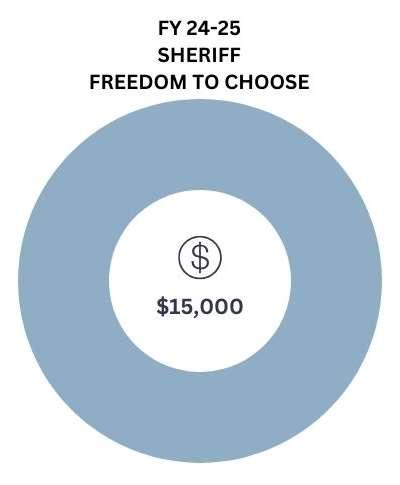

31

PRETRIAL ASSESSMENT
In January of 2020, the Santa Barbara County Probation Department assumed responsibility of the Pretrial Assessment Unit from the Santa Barbara Superior Court. The units consist of two (2) Supervisors, two (2) Senior Deputy Probation Officers (DPOs), and eleven (11) Pretrial Supervision Specialists (PTSS), to cover the north and south regions of the county. The PTSS utilize the Virginia Pretrial Risk Assessment Instrument-Revised (VPRAIR) to assist in the investigation and evaluation of a defendant’s risk level of failing to appear in court and reoffending while on pretrial release, while maintaining the presumption of innocence, and providing protection to the public. The Pretrial Assessment Unit assesses defendants seven (7) days per week and completes reports for their first scheduled arraignment, providing the Courts with information to assist with release decisions based on evaluated risks. Workload in these units has increased steadily, from a total of 3,263 reports authored in FY 20-21, to 4,564 in FY 22-23, an increase of 40% (Figure 8). The PTSS may refer defendants to the Pretrial Service Navigator (PSN) if Pretrial Supervision is recommended. Currently, the CCP does not fund any Pretrial Assessment staff. However, there is a seamless transition of records and assessment information that is used by the pretrial supervised release program.
CompletedPretrialAssessmentReports
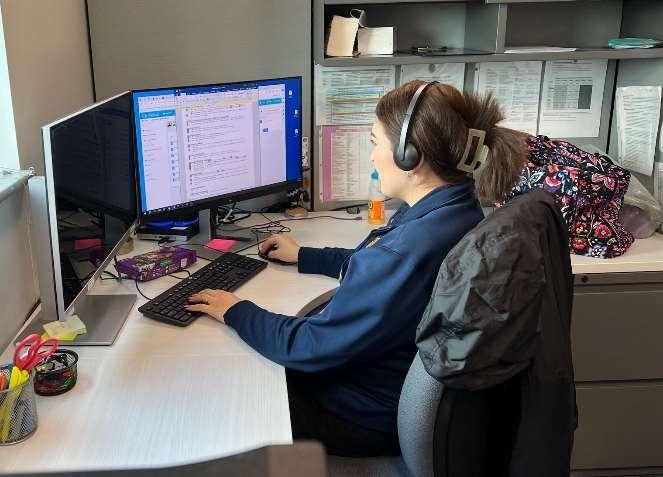

32
3,263 4,027 4,564 4,676 FY20-21FY21-22FY22-23FY23-24
2,338
Figure 8: Pretrial Assessment Reports
PRETRIAL SUPERVISED RELEASE PROGRAM 8
SeniorDeputy ProbationOfficer (2.0FTE)

$375,300
SupervisionServices andSupplies

$40,000
PretrialServices Navigator (4Positions)

$435,600
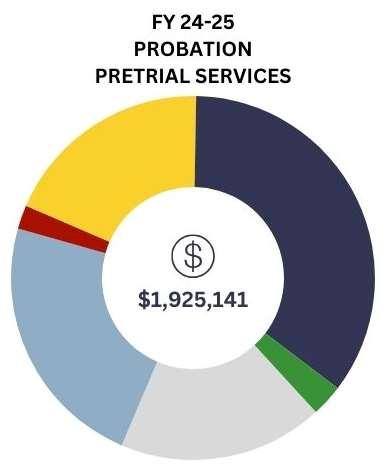
The Santa Barbara County Pretrial justice system is committed to effectively supervising individuals released on pretrial supervision, reasonably assuring attendance at court hearings while maintaining the presumption of innocence and providing protection to the public. Deputy Probation Officers (DPOs) serve as Pretrial Compliance Officers (PTCOs) to monitor clients and their adherence to conditions of supervised release. The PTCOs communicate the progress of clients via memorandum reports to the judicial officer and attorneys. PTCOs supervise defendants according to their risk level and may be responsible for the installation of Global Positioning System (GPS) monitors, responding to Secure Continuous Remote Alcohol Monitoring (SCRAM) violations, and completing violation reports or warrant requests. During this past fiscal year, the Pretrial Supervised Release Program experienced a continued growth of defendants being released on some form of pretrial supervision.
DeputyProbationOfficer

(4.0FTE)
$665,000
ServicesandSupplies

$53,441
PretrialServicesIntakeDPOs8 (2.0FTE)

$355,800
The Pretrial Supervision program began July 2017 with funding approved by the CCP. The number of defendants beginning pretrial supervision (Figure 10) continues to be greater than the number of clients exiting each fiscal year, resulting in an increase in the total number of clients on pretrial supervision as of June 30th of each reported year. The median days a defendant remains on pretrial supervision has remained relatively stable at 2.5-3 months over the past three fiscal years. While there has been an increase in the number of clients supervised on pretrial, it does not appear to be due to the length of stay on pretrial. The majority (67%) of individuals on pretrial supervision were successful (Figure 9). These are individuals who reported to pretrial staff, continued to report, appeared for scheduled court appearances, and did not have any new offenses during their monitoring period. In FY 22-23, 28% of people either failed to appear at their court hearing or received a
8
PretrialSupervisionOutcomes
33
One-time allocation for
Successful 67% Other 3% Remand 2% Misdemeanor Arrest 2% Felony Arrest 4% FTA 22%
FY 24-25.
Figure 9: Pretrial Supervision Outcomes

new arrest (misdemeanor or felony) during their pretrial period. Upon examination of this population, these individuals continue to be those that are unhoused, and have mental and/or substance abuse vulnerabilities and are the individuals that are targeted to be served by the Pretrial Service Navigators
PRETRIAL SERVICE NAVIGATORS
In July of 2019, the Judicial Council of California awarded the Santa Barbara County Superior Court a grant to expand the Santa Barbara County Pretrial Program for the period of August 1, 2019, through December 31, 2021. In an effort to increase the safe and efficient release of arrested individuals with mental health challenges on Pretrial Supervision, two Mental Health Navigator (MHN) positions, later renamed Pretrial Service Navigator (PSN) positions, were funded.
While the navigator positions were initially focused on those clients with mental health challenges, a review of the overall numbers of unsuccessful completions noted other vulnerabilities and acute needs played a factor in their inability to make it to their scheduled court hearings. This included being unhoused and suffering from substance abuse issues, or a combination thereof, and mental health issues. In an effort to assist with other vulnerabilities, the positions were renamed Pretrial Services Navigators (PSNs), and their scope was no longer be limited to only clients with mental health challenges.
Figure 10: Individuals on Supervised Pretrial Release: FY 19-23
PretrialSupervisionStarts&ClosuresbyFiscalYear
PSNs attend court hearings on designated clients to provide information to the Court on progress during the program or to advise of discharge planning details. A key component of the PSN position is the “warm hand off” of clients granted supervised pretrial release to services providers. This service is bolstered by the ability of the PSN to provide transportation to appointments and/or to obtain psychotropic medications as appropriate. The PSN positions follow up with mental health services providers, provide updates at subsequent court hearings, as needed, and accompany individuals to
34
401 715 844 1,441 1,660 325 511 836 1,197 1,555 131 335 343 587 624 FY2019FY2020FY2021FY2022FY2023 Starts Closures OnSupervisionasofJune30th
subsequent court dates. The PSN position links resources together and serves as a key influence in the success of the individual while in the pretrial process to provide service coordination in an effort to facilitate release on, and successful completion of, pretrial supervision. For FY 24-25, four (4) PSNs are funded through Realignment funding.
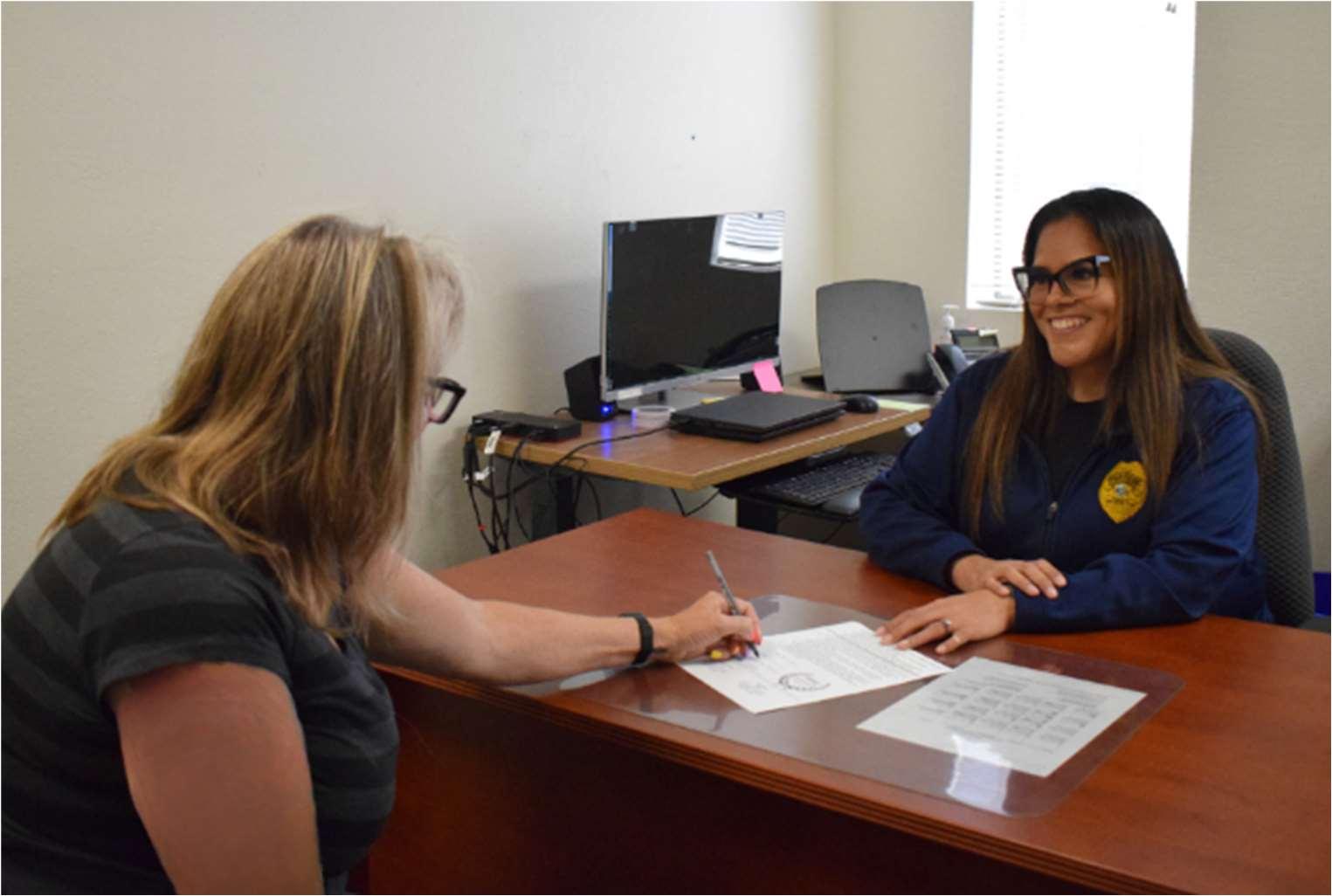
35

DETENTION ALTERNATIVES
RE-ENTRY COORDINATOR
Multi-AgencyAssessment, CasePlanningandRe-entry Coordinator

(1.0FTE)
$202,900
ServicesandSupplies

Sheriff
$5,000
DeputyProbation OfficerAssessor
(2.0FTE)
$359,200


GPSUnits–Sheriff

$100,000
The Re-entry Coordinator position, was designed to enhance collaboration between partner agencies on discharge and re-entry planning efforts. Through collaboration amongst partner agencies and the leadership of the Re-entry Coordinator, individuals entering the criminal legal system may receive multiagency assessments and case planning to assist in their successful return to the community. This is done at the earliest stage possible based on the individuals needs, ensuring a robust discharge plan is available prior to their exiting the criminal legal system (pretrial and post sentence). Re-entry planning interfaces with work performed by multiple agencies, including Probation, the Sheriff’s Office, the Public Defender’s Office and the Jail Discharge Planning Team.



$200,000
Initial attempts to recruit for the position were unsuccessful, therefore, a Probation Manager was temporarily assigned to serve in the special assignment until the position can be permanently filled. For the upcoming Fiscal Year, the position was elevated from a Team Project Leader to a Program Business Leader, to recruit a highly qualified, non-sworn candidate to assume this dynamic and instrumental position.

36
CustodyDeputy (1.0FTE) $187,200
DiversionEfforts Services $832,510
DischargePlanningServices
VICTIM SERVICES
The District Attorney’s Victim-Witness Assistance Program provides early intervention to victims of crime at the arraignment stage and pre-filing. Delayed intervention creates additional collateral stress for victims who are unaware of the criminal justice system, their rights, or critical services available in the aftermath of a crime. To expedite services and mitigate victims’ crises, the District Attorney’s Office works diligently to serve victims at the earliest moments following the crime.
EARLY INTERVENTION SERVICES
The Victim-Witness Assistance Program has dedicated one (1) fulltime Victim Advocate to be on-call and available for walk-in victims to the Arraignment Courts and the District Attorney’s Office. The additional Advocate is available to victims in crisis seeking services or case information, including:
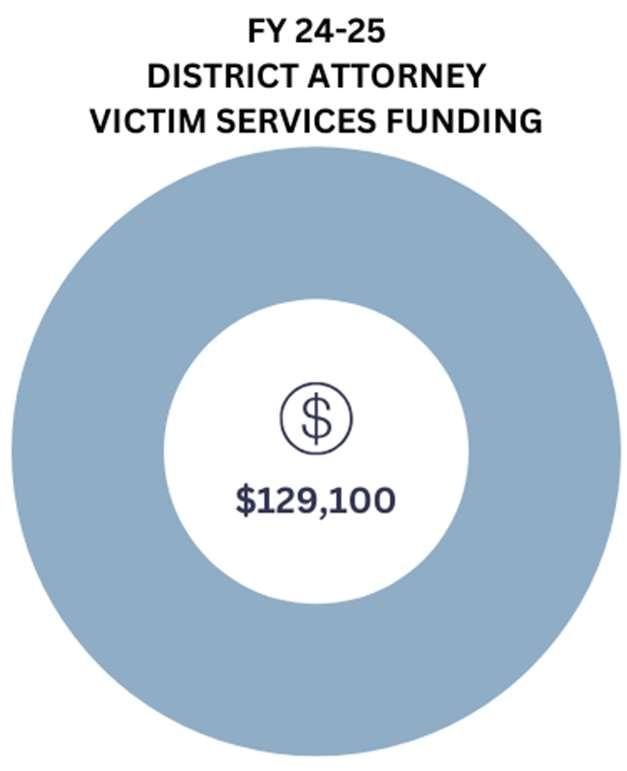
Restitution Determination: The Advocate proactively contacts and responds to victims to determine restitution prior to arraignment. The Advocate determines the victim’s losses and obtains supporting documentation to establish the court ordered restitution amount. Early restitution determination mitigates unnecessary continuances, ensures resource management for Deputy District Attorneys and the Probation Department, and recoups victims’ losses expeditiously.
Safety Concerns: The Advocate’s presence in court and on-call also expedites victims’ access to services, which include crime prevention assistance and criminal protective orders provisions.
California Victims’ Bill of Rights (Marsy’s Law): The allocation of resources has enhanced the Victim-Witness Assistance Program’s ability to meet the constitutional requirements of Marsy’s Law, which include providing timely notice of case status, custody status, assessing safety and determining restitution.
The District Attorney’s ability to make early contact with victims of crime leads to better outcomes for both the individual accused of a crime and the victim. The earlier the intervention, the less likely victims will be re-victimized or decompensate emotionally due to lack of information and services. Early interventions can also reduce defendants’ court appearances, minimize criminal justice partners’ staff time related to protracted court appearances, and expedite case dispositions.
Recognizing the importance of early victim engagement, in recent years the arraignment court has increased requests to Victim-Witness advocate staff to meet with victims who appear in court or to call victims and obtain input at the time of arraignment.
During the period of July 1, 2023, through December 31, 2023, a total of 1,365 victims were contacted at or before arraignment and received safety planning guidance, case status, orientation to the criminal justice system, restitution assistance, and victim’s rights notification per Marsy’s Law. Of these 1,365 victims, 248 were provided services with the funding provided by the Community Corrections Partnership (CCP).
37
Victim Witness Advocate (District Attorney) (1.0 FTE)

DISCHARGE PLANNING
Discharge planning and addressing the needs of justice-involved individuals leaving custody and reentering the community is crucial to ensure a successful transition. By implementing effective discharge planning strategies, the potential for successful reintegration and connection to services is enhanced, which can have a significant positive impact in reducing recidivism. The Santa Barbara County Discharge Planning Team works diligently and collaboratively, using evidence-based assessment and treatment practices, to help integrate these individuals back into our community.
Discharge planning referrals are received from a variety of sources, including: Clients
Family Members
Defense Counsel
For FY 23-24, the Discharge Planning Team received and processed 723 referrals for assistance to connect with treatment programs, sober living residences, residential treatment programs, and housing. These referrals also address many areas of need for clients, including assisting with obtaining valid government-issued identification, securing supplemental and disability social security income, applying for benefit entitlements such as Medi-Cal, and enrolling in veterans benefit programs. The level and extent of assistance is based on risk and needs, as determined through the use of evidence-based screening and assessment tools.
A major component of discharge planning focuses on coordinated service delivery, addressing housing needs, and facilitating assessment for treatment referrals.
The current Discharge Planning Team consists of one Community Release Specialist, one Discharge Planner contracted through the Sheriff’s Department, two Deputy Probation Officers (DPOs) assigned as Jail Assessors (JAs), and two Rehabilitation Services Coordinators employed through the Public Defender’s (PD) Office. This multidisciplinary approach allows the team to utilize their skills and knowledge as they collaborate in the assessment of inmates’ needs and subsequent discharge planning.
In addition to the efforts of the Discharge Planning Team and PRRC staff, multiple county departments and agencies partake in re-entry and discharge planning efforts. These efforts include, but are not limited to, additional work by Probation, the SBSO, Behavioral Wellness, Santa Barbara County Department of Social Services, and the Public Defender’s Office. Behavioral Wellness staff process inmates into the ACCESS line utilizing appointments within the jail for connection to appropriate services. Wellpath confirms any medications for inmates and assists in processing inmates’ release with prescriptions. Social Services assists with confirmation of, and assistance with, inmates applying for Medi-Cal. Holistic Defense staff serve as advocates to assist clients with mental health needs and transportation. Public Defender advocates also assist with transportation needs, and Public Defender

38
discharge planners assist clients with getting into residential treatment programs. To enhance the above coordination and collaboration between agencies, the Re-entry Coordinator position was added as described on page 36. An additional $200,000 funding remains in the FY 24-25 budget and is earmarked for activities or resources which may be needed to support this work.
PROBATION REPORT AND RESOURCE CENTERS (PRRC)
The Probation Report and Resource Centers (PRRC) serves as a critical point of service for justice involved individuals, including Realigned clients, to access services and support to allow them to successfully reintegrate into their community. When clients are released from jail or prison, they often have a variety of basic needs that must be addressed prior to starting a rigorous structured treatment program. The PRRCs offer a foundation for clients to stabilize so they can begin their journey to success. This may include food, clothing, or other basic necessities. The road to success continues with meeting with a Re-Entry Specialist who uses an evidence-based assessment to further determine risks and needs. Based on the client’s individualized results, a case plan is strategically developed to prioritize the client's specific risks and needs in order to provide programming options that are meaningful and effective. Clients can also be referred to the PRRC by their assigned supervision officer at any time while they are on probation.

The PRRC offers clients an environment conducive to positivity and success where they are able to gain the necessary skills, confidence, and direction, to overcome the various barriers which they may be facing. Staff assigned to the PRRC support clients through positive growth through education and treatment to meet their various needs such as job development, job placement, housing, and substance abuse and mental health. Programming includes cognitive behavior therapy-based interventions and trauma-informed care. The PRRCs are located in both Santa Barbara and Santa Maria and are staffed with probation officers, community-based organizations, Behavior Wellness and an AmeriCorps service member. Those

39

individuals residing in Lompoc may access services from Santa Maria either virtually or have other options available through local community-based organizations. When clients are released from jail or prison, they begin their journey at the PRRC by meeting with a Re-Entry Specialist who uses an evidencebased assessment to determine the client’s risks and needs. Based on the client’s individualized results, a case plan is strategically developed to prioritize the client's specific risks and needs in order to provide programming options that are meaningful and effective. Clients can also be referred to the PRRC by their assigned supervision officer at any time while they are on probation.
Pharmaceuticals

$20,000
SeniorDeputyProbation Officer-PRRC(1.0FTE)

$189,500
UnitedWayStipend–Probation

$12,000
DeputyProbationOfficer-PRRC(1.0FTE)
$196,900
TreatmentandRe-Entry Services
$1,814,792

ContractDischargePlanner-Sheriff(CBO)
$108,500
OfficeSupplies–Sheriff

$5,000 AOP-PRRC(1.0FTE)


$116,500CommunityReleaseSpecialist-Sheriff(1.0FTE)

$101,400

40
HOLISTIC DEFENSE
The Community Defender Division (CDD) is the main component of Holistic Defense designed to remove barriers while promoting the dignity of individuals through advocacy, innovation, and collaboration. The Public Defender’s model of holistic defense is a team-based re-entry model in partnership with multiple agencies. These teams work to address socially rooted problems, beyond simple criminal risk, such as homelessness, unemployment, and addiction. Clients, attorneys, and advocates work in teams to secure pretrial release from jail, address client needs (housing, mental health, etc.), and ultimately reduce interaction with the legal system. Holistic defense interrupts cycles of criminal legal intervention by improving case outcomes so reentering individuals can stabilize their lives. Diversion from the criminal legal system is a shared goal by all of the pillars of criminal justice and a demand of the community upon all stakeholders.
The CDD provides caring, complex, and courageous advocacy and services for clients. Staff within the CDD work toward long-term systemic changes to improve the lives of the most vulnerable. Within the CDD, there are four (4) Holistic Defense Advocates who are highly skilled Masters Level Social Work (MSW) practitioners who assist with case supervision and assessments with a focus on those who are mentally ill and at risk of being found incompetent to stand trial. They work with housing advocates, resource specialists, and attorneys to assist people in correctional facilities. These client-centered teams employ interdisciplinary approaches, build capacity, and improve community-based systems to achieve more successful legal and life outcomes for those people who are justice-involved.
The Holistic Defense Advocates duties include: social work interventions aimed at improved legal and life outcomes for clients, biopsychosocial assessments, mental health testing and treatment, drafting mitigation reports, facilitating improved trust and communication between attorney and client, conducting short-term supportive counseling, crisis intervention, stabilization and psychoeducation, and identifying client needs and coordinating resources. The CDD directly addresses the underlying life circumstances that lead clients to criminal justice involvement, such as addiction, mental illness, family dynamics, and housing instability.
To increase collaboration, efforts continue to strengthen partnerships with community organizations and other agencies including the Sheriff’s Office, WellPath, Homeless Services, Good Samaritan and Behavioral Wellness, to ensure seamless and continued access to therapeutic services, housing, and other essential needs.







To address the needs of clients and improve legal and life outcomes, CDD receives funding from the CCP for Client Resource Advocates, Housing Specialists, and Rehabilitation Services Coordinators.
41
Advocate/Social WorkersMSWPublicDefender (4.0FTE) $537,000 LOPPublicDefender (1.0FTE) $91,200LicensedClinical SocialWorker (1.0FTE) $161,600 TravelExpensesPublicDefender $75,000 ADMHS RecoveryAssistant (3.0FTE) $297,500 ClientServicesSpecialist (1.0FTE) $118,600

CDD assisted clients in the following areas: finding housing, addressing substance abuse, connecting with medical insurance, linking to mental health treatment, and overall case management. All CDD staff are funded through grants and CCP, with total staff during FY 23-24 at 15 individuals.
CLIENT RESOURCE ADVOCATES
Client Resource Advocates balance in-person and remote services to incarcerated clients. CDD has further enhanced collaboration with Wellpath Medical and Mental Health Services to ensure Public Defender clients with Serious and Persistent Mental Illnesses, Incompetent to Stand Trial (IST), and at risk of being IST are connected to medication and psychiatric services while in custody. This also included working with the SBSO to advocate placement in the new Behavioral Health Units.
HOUSING SPECIALISTS
Ongoing partnerships continue with United Way AmeriCorps to provide three (3) AmeriCorps members to provide services with regard to housing navigation and housing advocacy. Current staffing provides four (4) total service members covering each area of the county (Santa Maria, Lompoc, and Santa Barbara).
REHABILITATION SERVICES COORDINATORS
Through Realignment funding, the Public Defender employs two (2) Rehabilitation Services Coordinators, one (1) in Santa Maria and one (1) in Santa Barbara, to connect incarcerated individuals living with primary Substance Use Disorders to long and short-term, communitybased treatment programs as part of their sentencing requirements.
BEHAVIORAL HEALTH SERVICES

$42,000


The Department of Behavioral Wellness (BWell) provides a range of services to the Realigned population that includes clinical assessment, medication monitoring, and case management. These services are delivered by a 0.25 FTE Psychiatrist, a 1.0 FTE Licensed Psychiatric Technician, and a 0.25 FTE Mental Health Practitioner. The BWell and Probation staff work collaboratively towards achieving positive outcomes with the individuals who receive services. BWell staff are located at the PRRCs in Santa Maria and Santa Barbara, which facilitates close communication with Probation counterparts and access to the Realignment clients referred for treatment. The Psychiatric Technician and Practitioner travel to Lompoc to provide services to Realigned clients in that region at a minimum of once per month.


In FY 22-23 a total of 15 clients were served in the AB109 clinics with a total of 94 services being provided. Seventeen (17) clients were served in Mental Health clinics with 66 services provided. Individuals referred for clinic services receive a clinical and diagnostic assessment aimed at identifying behavioral health and substance abuse problems. A psychiatric assessment may be completed, and
42
MH
Practitioner/Post DocIntern (0.25FTE)
PsychiatristTechnician (1.0FTE) $134,600 Psychiatrist (0.25FTE) $99,700 AdditionalMH Services $190,100
based on the findings, an individual may be prescribed psychotropic medication. Those receiving psychiatric services undergo follow-up appointments with the psychiatrist and psychiatric technician to monitor the efficacy of their medication(s). Some individuals are referred to additional services, such as substance abuse treatment. Program participants open to engaging in services are assessed for level-ofcare needs and linked to long-term BWell programs for ongoing treatment during and after discharge from supervision. Fifty (50) clients were served in Alcohol and Drug programs with 692 services provided in a residential setting and 1,436 services provided in an outpatient setting. (Figure 11)
43
48 23 21 15 13 38 16 17 6363 95 50 124124 132 82 FY19-20FY20-21FY21-22FY22-23 CLIENTSSERVED&SERVICESPROVIDEDBY DEPARTMENTOFBEHAVIORALWELLNESS AB109ClinicsMentalHealthOutpatientAlcoholDrugProgramTotal
Figure 11: Clients Served by Department of Behavioral Wellness

CO-RESPONSE TEAMS
9
In 2018, the Sheriff’s Office (SBSO) and BWell began a co-response pilot with one team. In 2019, the county was able to secure two (2) million in funding through several grants to fund three (3) full time teams. Santa Barbara County currently has three (3) full-time Co-Response teams staffed with Sheriff and BWell employees. Two (2) of the teams operate in South County and one (1) operates primarily in North county, but does respond to calls in the Lompoc and Santa Ynez Valley region. In 2020, the existing teams showed great success in responding to close to 50% of all mental health calls. Since then, there has been an increase in volume and acuity of calls. The teams covered 25%-30% of all crisis calls coming into SBSO dispatch. Mental health calls responded to by Co-Response teams lead to an arrest less than 1% of the time and allow for patrol deputies to be diverted back to patrol duties.
As noted, Co-Response has been found to be an effective intervention to address the behavioral health needs of individuals in the community experiencing a behavioral health crisis that may otherwise be routed through the criminal justice system. Co-Response includes a Deputy trained in Crisis Intervention Techniques (CIT) and a BWell clinician who work together 40 hours per week.





COMMUNITY SUPERVISION & CASE MANAGEMENT
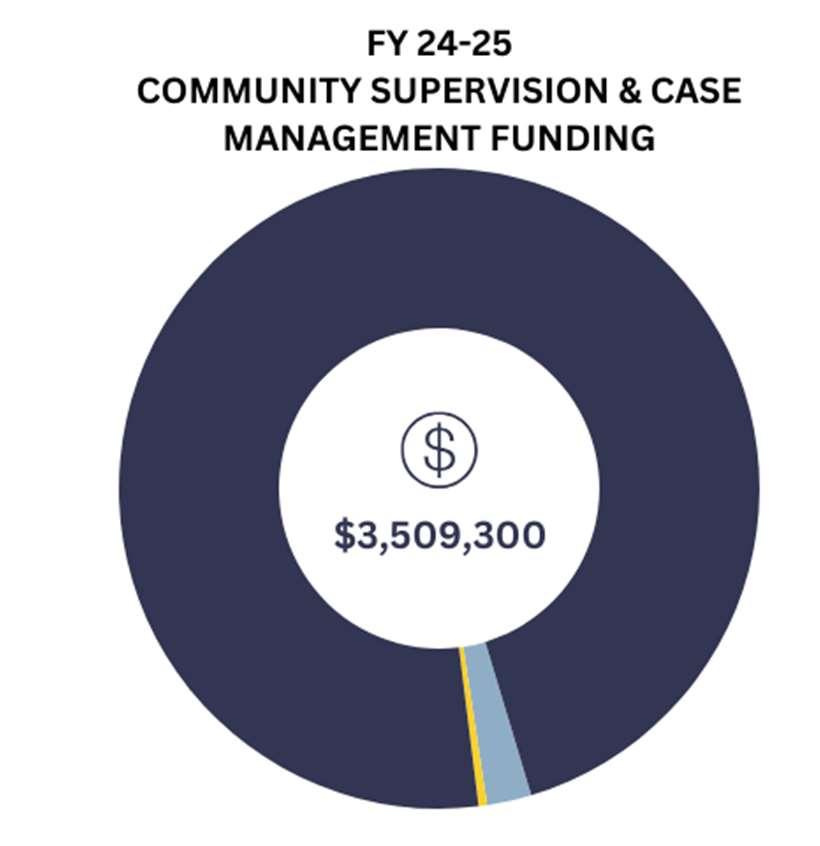



The Santa Barbara County Probation Department is dedicated to providing the most effective case management to clients under any form of supervision in order to reduce recidivism and ensure community safety. A major focus of the case management provided by Deputy Probation Officers (DPO) follows the risk-needsresponsivity (RNR) model. These efforts are targeted to improve client-centered outcomes and ultimately work towards reducing recidivism. DPOs utilize evidence-based interventions and supervision practices to effect positive behavioral changes among those under their supervision. To remain effective in their efforts, staff complete annual trainings to further support and enhance their knowledge and case management skills, including annual training on evidence-based practices (EBP). Motivational Interviewing (MI) is a skill that officers achieve certification and must maintain proficiency. MI allows officers to engage in
44
9Includes a Medi-Cal billing offset of $25,000 for FY 24-25. ProbationStaff $3,420,200 OperatingExpenses $79,100 Urinalysis $10,000 MotorPool-Sheriff $30,000BWellAdmin $18,500 SheriffDeputy S/D(1.0FTE) $225,100 Training,Services,
$3,000 LicensedMental HealthPractitioner -BWell $154,500
&Supplies-Sheriff
meaningful change, talk and establish short and long-term goals, remove barriers, and move the client through the stages of change to achieve the desired goal. DPOs use the directed skill sets to promote areas of change that can lead to more prosocial behaviors and better outcomes. Realigned clients are assigned to supervision officers with optimal caseload ratios to ensure frequent interactions either in the office or in the community. Supervision officers monitor and coordinate advanced case planning driven by evidence-based assessments which allows targeted case management and supervision. Treatment plans are individualized to the justice-involved individual and updated as progress toward treatment goals is achieved.
In their day to day efforts, DPOs collaborate with a variety of service providers and CBOs. As an example of how DPOs maintain open communication with providers and other team members, they participate in monthly Realignment wraparound meetings held at the PRRC locations. This type of collaborative setting provides an excellent opportunity to discuss treatment services and cognitive behavioral interventions to determine new or adjusted treatment services.
The Santa Barbara Probation Department values a team approach to community supervision and case management.

HOUSING
A common obstacle facing individuals just released from jail or State Prison is often housing. Being unhoused can create a situation where it is difficult to remain clean and sober, find employment or engage in re-entry services. The Community Corrections Partnership continues to focus on a multi-dimensional approach to offer options for housing, including shelter beds, sober living, transitional housing, and a brick-and-mortar project.
SUPPORTIVE & TRANSITIONAL HOUSING
In an effort to provide a higher level of support and case management, the Realignment funding supports 20 transitional supportive housing beds. The local Community Based Organization Good Samaritan Shelter, provides the transitional supportive housing beds10 to justice-involved individuals under community Supervision who are medium to high risk to recidivate and are reentering into the community after lengthy incarceration without natural supports available for housing assistance. Additionally, these individuals may present with multiple areas of vulnerability such as mild to moderate mental health challenges and substance abuse challenges. Enrolled participants are assigned a case
10 Good Samaritan Shelter provides fourteen (14) beds in Santa Maria.
45
manager that works closely with them to identify and resolve barriers to obtaining and maintaining housing, including transportation to appointments and treatment. The programs connect participants to appropriate support services in the community to foster long-term housing stability. During their participation, the programs use a standard assessment to determine type, duration, and amount of assistance offered and identify the availability of other resources or support systems to resolve housing challenges. The ultimate goal is to foster selfsufficiency for independent living.
Through early recovery group processes, clients are taught to increase their self-awareness concerning substance dependence and abuse. Topics include: coping skills, high-risk situations and triggers, positive affirmations, self-esteem, stress management, relapse prevention, and introduction to the 12 Steps. For FY 2324, CCP approved the ongoing allocation of $400,000 for Transitional Supportive Housing beds.
SOBER
LIVING HOMES

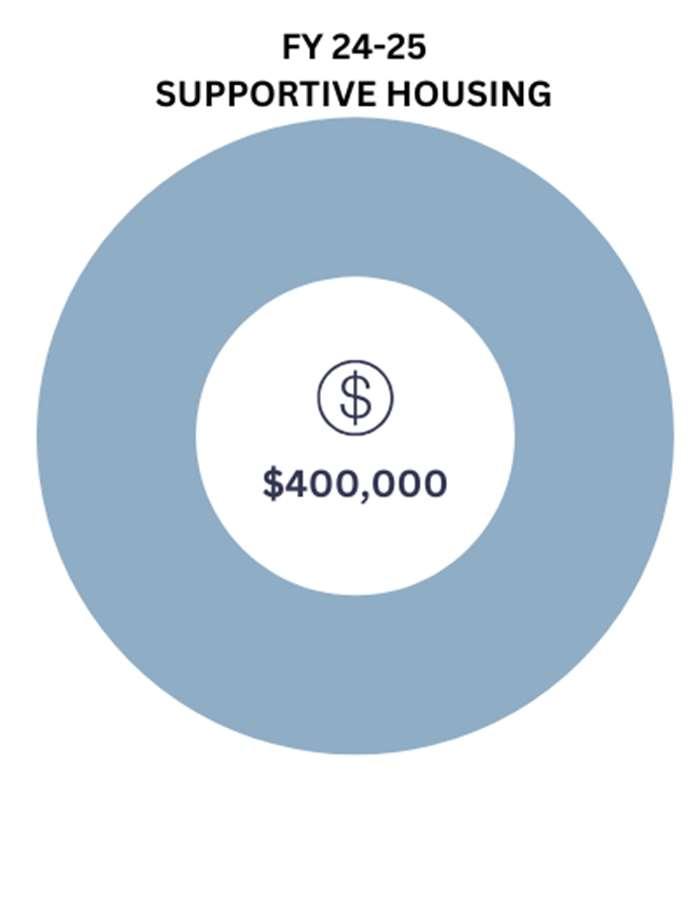
Securing a safe living environment can be challenging for individuals exiting jail or prison. The CCP approves Realignment funding to subsidize beds at community based sober living residences for clients to stabilize and work towards independent living. While at the sober living homes, house managers develop and utilize individualized case plans to assist in guiding and directing the clients in activities designed to move them toward self-sufficiency. Many of the sober living facilities participate in monthly regional wrap-around treatment team meetings with probation and treatment personnel.
From July 1, 2022, through June 30, 2023, 48 placements were made to sober living housing, specifically, 20 at Good Samaritan Homes, 10 at PATH, four (4) at Salvation Army Hospitality House, six (6) at Stalwart, and eight (8) at Willbridge.
Recognizing the need for immediate housing of clients coming from prison, clients who are 290 registrants, or other clients that are waiting to transition to sober living or supportive housing, the housing budget was increased by $30,000 for FY 24-25 to allow funding for additional beds.
WITHDRAWAL MANAGEMENT
Withdrawal Management beds are available through CCP funding to individuals seeking support during withdrawal, sometimes as an alternative to incarceration. These individuals may not meet the criteria for referral through the access line or there may not be any county beds available. The Withdrawal Management Residential Detox program follows a fourteen (14) day social model management approach. Clients engage in daily 12-Step meetings, participate in two (2) early recovery groups, and receive individual counseling and discharge planning.

46
SubsidizedSLE,Detox SupportiveHousing Program-CSD 100%
BRICK AND MORTAR HOUSING DEVELOPMENT
The Community Corrections Partnership previously allocated up to $1.65 million of one-time reserve funds to Sanctuary Centers for the development or rehabilitation of "Brick and Mortar" supportive housing for high to mediumrisk justice-involved individuals subject to community supervision by the Probation Department. The housing development will provide studio and one-bedroom permanent supportive housing units to the target population. Sanctuary Centers will use the $1.65 million to augment the $33 million housing project to be constructed at 115 W. Anapamu in Santa Barbara.

It is anticipated the project will be completed and the housing project will open in Fall of 2025.
HOUSING SPECIALIST
To assist with the supportive transitional housing program administration, support the Sanctuary Centers permanent housing project, help manage contract invoicing, and monitor program compliance and outcome measures, the Probation Department partners with Community Services – Housing and Community Development Division to fund a Housing Program Specialist.
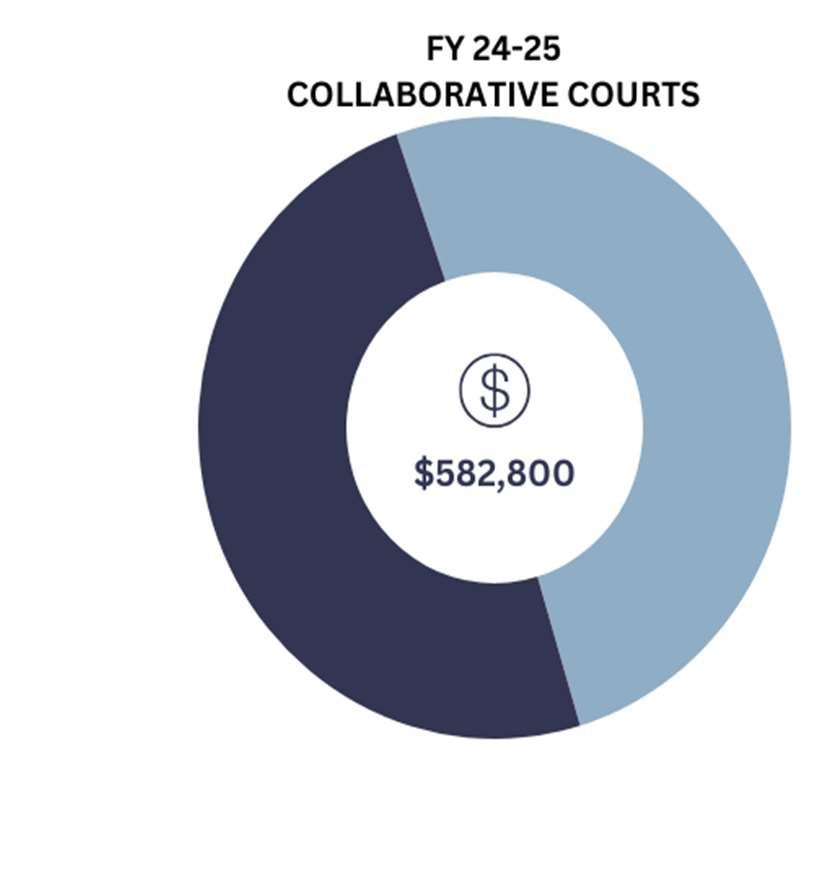
Collaborative Courts-District Attorney (1.0FTE)
$287,200
Specialty Court/MentalHealth DeputyPublic DefenderSr.(1.0 FTE)
$295,600

HousingSpecialist CSD/HCD(1.0FTE)

$120,000
4Housing Specialist -PublicDefender

$50,000

COLLABORATIVE COURTS
Santa Barbara County has a variety of Collaborative Courts within the Superior Court system to address cases in a specialized environment with a dedicated team. Investing in Collaborative Courts is specifically authorized under Penal Code §1230(d) as a justice reinvestment strategy, which states that evidence-based rehabilitation programs, including but not limited to, drug and alcohol treatment, mental health treatment, anger management, and cognitive behavioral programs, help maximize the effectiveness of criminal justice resources.
47





Prop36(PC1210) 0.7%

VeteransMilitaryDiversion PC1001.80(Pre-Plea) 10%


SubstanceAbuseTreatment Court(Pre-Plea) 7.1%


PUBLIC DEFENDER’S OFFICE COLLABORATIVE COURT ATTORNEY
The Public Defender’s Office Collaborative Court attorney represents clients in court settings where alternatives to incarceration, such as drug rehabilitation, mental health diversion, and intensive case management, are provided which can help to increase the use of diversion options. This attorney works with individuals in the criminal justice system experiencing substance abuse challenges, mental illness, homelessness, and other social welfare concerns, using evidence-based advocacy with a focus on recovery and connection to community-based services. In addition, this staff coordinates with other justice partners, community-based organizations, and social workers to optimize treatment and success.
DISTRICT ATTORNEY’S OFFICE COLLABORATIVE COURT ATTORNEY
For FY 24-25, Realignment funds were continued to enable the District Attorney’s Office to staff the Collaborative Courts with a 1.0 FTE Deputy District Attorney, allowing for full-time staffing of both northern and southern regions of the county. The clients assigned to these courts are often charged with Realignment-eligible offenses. These courts can provide positive, therapeutic alternatives to jail that help end the cycle of recidivism.
An analysis of court cases heard in the collaborative courts by court type from November 1, 2022, through October 31, 2023, revealed the majority to be mental health diversion cases; specifically, 54.8% (Figure 12).
48
CognitiveDiversion (PC1001.22) 1.2% MentalHealthDiversion (PC1001.36)(AB1810) 54.8%
Figure 12: Collaborative Courts Cases by Court Type
MentalHealthTreatmentCourt 17.2%
7.4% SubstanceAbuseTreatment Court(PostPlea) 1.6%
DualDiagnosisCourt
COMPLIANCE RESPONSE TEAM (CRT)
In December 2012, the Santa Barbara Probation Department and the Santa Barbara Sheriff's Office collaborated to establish Compliance Response Teams (CRT). For Fiscal Year 2024-2025, two (2) teams are funded and each team includes one (1) Senior Deputy Probation Officer and one (1) Sheriff Detective each assigned to Santa Maria and Santa Barbara respectively. In addition, a SBSO Sergeant is also funded to oversee field operations, enhance operational safety, and provide training and evaluation. The CRT teams also provide support to the Lompoc region.
The CRT team's responsibilities include conducting compliance checks on Realigned clients, providing support, and apprehending wanted individuals. With their high mobility and rapid response abilities, the CRT members spend the majority of their day in the community, engaging with clients and addressing the needs of both the clients and their assigned case officers. The CRT places a strong emphasis on promoting client wellness and providing client support. They prioritize the needs of clients by offering services such as transportation from jail and facilitating transportation to sobering centers and residential treatment programs. (Figure 13)
The CRT Teams incentivize client behavior whenever possible and also utilize support sheets provided by Deputy Probation officers. The support sheets share information with CRT, enabling incentives and/or interventions with clients prior to re-offending, violating the terms of their supervision or becoming subject to a warrant.
The CRT Teams strive to strike a balance between supporting the Realigned population and ensuring public safety. In addition to the above, the CRT teams support local law enforcement in incidents or operations involving the Realigned population and are deployed as needed on a countywide basis. The CRT teams have successfully removed narcotics, firearms and other weapons from the community as noted in figure 13.
The CRT program remains a valuable component of the local efforts to effectively supervise and support the Realigned population while continuing to strive to meet the expectations, goals, and core values of the CCP.

49
Compliance Checks Oct 2020 to Sept 2021 Oct 2021 to Sept 2022 Oct 2022 to Sept 2023 Arrested Transportation Fentanyl Incentive Cards Knives Amphetamine/ Methamphetamine Firearms Other Heroin 985 719 633 55 53 60 46 55 48 298 M-30 pills 26 11 7 7 1.5 gm 149.7 gm 8 0 48 55 6 8 77 1 13 20 2.9 lbs 181.01 gm 11 gm 17.2 gm 14.3 gm 34 gm 14.5 gm Offender Support Activities: Weapons Confiscated: Drugs Confiscated:
Figure 13: Compliance Response Teams (CRT)
REGIONAL REALIGNMENT
RESPONSE FUND
Guadalupe Police Department (GPD) is budgeted $5,000 to support operations on an overtime basis to respond to incidents related to the Realigned population of justice-involved individuals and to participate in multi-agency operations to conduct warrant apprehensions or other operations as coordinated by the CRTs. As the smallest police department, it was determined that GPD required this funding to continue its activities under Realignment.


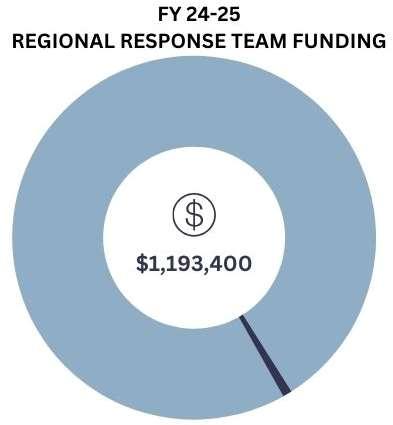






ADMINISTRATION

To ensure the proper administration of Realignment funding, Santa Barbara County’s CCP recommends a moderate administrative expense relative to each County department’s direct program expenditures. Each County department receives 3% of the direct program expenditures they administer with the exception of BWell, which receives 12%. Realignment also requires Auditor-Controller resources resulting in the allocation of 0.5% of countywide direct Realignment expenditures to fund such requirements.
DATA COLLECTION & EVALUATION
Santa Barbara County is committed to informing the local criminal justice system of actionable strategies to improve practices aimed at reducing recidivism of its Realigned clients. To date, 11 evaluations providing valuable insights have been funded through the CCP11. In FY 24-25 the partnership has committed to a process evaluation of the County’s diversion programs. It is anticipated the evaluation will examine the existing options across the county that redirect adults from the traditional criminal justice system. This will include documenting program design and implementation, participant experiences as well as the target population served by each, the criteria used to determine suitability and eligibility of individuals for each program, indicators of net-widening as well as identify areas of strength and improvement including any gaps and/or duplication in program efforts. The findings from this effort will ultimately inform the effectiveness of the County’s diversion efforts and future outcome evaluations.
50
11 Published evaluation reports are available to the public on the Probation Department’s website at www.sbprobation.org Probation Admin $313,100 District Attorney $21,000 Behavioral Wellness $78,800 Auditorcontroller $102,100 PublicDefender $52,800 SheriffAdmin $118,400 RegionalResponse Teams $1,188,400 RegionalRealignment ResponseActivityFund (GuadalupePD) $5,000
SANTA BARBARA COUNTY DATA SHARING COMMITTEE
The Santa Barbara County Data Sharing Committee (SBCDSC) is a collaboration of six (6) agencies working in partnership to facilitate cross-agency data sharing. This collective effort to gather comprehensive information for decision and policymaking includes the Santa Barbara Sheriff’s Office, District Attorney, Public Defender, Superior Court, BWell and the Santa Barbara County Probation Department.
The SBCDSC is tasked with developing a data exchange infrastructure, process, and governance to enhance the ability to collect and analyze data on shared clients and improve data integration between agencies.


$68,796


To this end, the group developed a County Integrated Information System (CIIS). The CIIS is an innovation that resolves a core issue of cross-agency data sharing through its creation of a virtual ‘handshake’, or index allowing disparate systems to identify common clients regardless of where a justice-involved individual’s data exists. With this in place, partner agencies can confidently connect their data and begin to explore workload efficiencies and applications to improve customer service as well as create reports and visualizations of the data. In FY 24-25, the number of agencies participating in the CIIS is expected to expand to include the Public Health Department, Department of Social Services and Community Services Department.
In addition to authorizing particular recurring data exchanges between departments for workload efficiencies, the SBCDSC and CIIS have been critical to improving transparency and public access to criminal justice data through two public-facing data dashboards. The Santa Barbara County Probation Dashboard can be accessed directly from the Department’s website at www.sbprobation.org.
Additionally, the Santa Barbara County Sheriff’s Office dashboard is available https://www.sbsheriff.org/data-dashboard/.
Santa Barbara County’s CCP is committed to continuing to improve the public’s access to data and is actively exploring opportunities to further advance the work of the SBDSC including opportunities for an interactive, real-time data dashboard incorporating data from all criminal justice partner departments.
RECIDIVISM
Recidivism is a key outcome measure for practitioners to evaluate the extent to which programs and services are changing behavior. AB1050 required the Board of State and Community Corrections to draft and approve a statewide definition of recidivism. The approved statewide definition of recidivism is a new felony or misdemeanor conviction three (3) years from the start of supervision or release from custody. This is an important indicator because it allows practitioners to examine the rates in which clients are reoffending in comparable time frames, providing an “apples-to-apples” comparison of recidivism across all Realigned populations, whether or not they receive supervision.
51
Evaluation
EDPSystems & Programming Analyst (1.0FTE)
AccountantI (0.5FTE) $73,600 Department BusinessSpecialist (1.0FTE) $160,800
$162,600

Displayed below are data for nine (9) years of PRCS and PSS clients who started supervision in 2011 through 2019. For example, of the PRCS clients who started supervision in 2019, 41.8% recidivated within three (3) years through 2022. The clients’ highest recidivating event in that three years (either misdemeanor or felony) is also provided for each population.
Figure 14: PRCS Recidivism 3 Years from Start of Supervision
PRCS:Recidivisim3YearsfromStartofSupervision [BSCCDefinition]
Figure 15: PSS Recidivism 3 Years from Start of Supervision
PSS:Recidivism3YearsfromStartofSupervision [BSCCDefinition]
52
27.7%24.9%28.0% 15.9%20.2%17.9%15.7%16.9%17.0% 26.9%25.3%22.3% 26.5% 30.5%36.6% 28.4%25.7%24.8% 54.6% 50.2%50.3% 42.4% 50.7% 54.5% 44.0%42.6%41.8% 0.0% 10.0% 20.0% 30.0% 40.0% 50.0% 60.0% Clients Startingin 2011 Clients Startingin 2012 Clients Startingin 2013 Clients Startingin 2014 Clients Startingin 2015 Clients Startingin 2016 Clients Startingin 2017 Clients Startingin 2018 Clients Startingin 2019
MisdemeanorFelony TotalRecidivism 25.0%20.9%28.3%16.5%22.6%19.6%20.0%25.5% 25.0%29.5% 24.1% 34.4%22.7%31.4% 20.0% 19.6% 50.0%50.4%52.4%50.9% 45.3% 51.0% 40.0% 45.1% 0.0% 10.0% 20.0% 30.0% 40.0% 50.0% 60.0% Clients Startingin 2012 Clients Startingin 2013 Clients Startingin 2014 Clients Startingin 2015 Clients Startingin 2016 Clients Startingin 2017 Clients Startingin 2018 Clients Startingin 2019
MisdemeanorFelony TotalRecidivism
VI. CLOSING
During FY 23-24, the Santa Barbara County Community Corrections Partnership (CCP) continued to invest in strategies to reduce incarceration, increase diversion opportunities and early defense, improve re-entry coordination, and enhance programming for clients and victims. In order to accomplish the bolstering of services, a large portion of funding from the CCP restricted fund balance was used as onetime allocations to launch new initiatives that will occur over the course of one to three years. This includes: the Racial Justice Act attorney, two Mental Health Diversion Paralegals, and the READY program within the Public Defender’s Office; the Victim Witness Advocate who specializes in Domestic Violence cases, a District Attorney staff dedicated to the upgrading of their case management system and a Diversion Director within the District Attorney’s Office; the addition of Pretrial Intake Officers within the Probation Department to allow for more efficient and same day intake services in Santa Barbara and Santa Maria; the addition of 20 supportive housing beds for justice involved clients in the northern region of the county; the funding for a pilot program to secure treatment beds for justice involved behavioral health diversion clients who are in custody and eligible for LPS conservatorship at the Champion Center; and the funding of a justice involved individuals focus group, called Valuing Voices, to support a systemic approach to studying and addressing racial and ethnic disparities in the justice system.
The CCP Executive Committee and General Membership, alongside collaborative agencies, department staff, and the community, remained engaged in the ongoing discussions that led to the improvements and expansions aimed at addressing the needs of clients across different areas of the community.
This Realignment Plan represents the dedication of the justice partners throughout the County of Santa Barbara, in the support of innovation, client centered services, and the improvement of public safety using evidenced based practices. Over the course of the coming year, discussions and decisions will revolve around the collection and review of data to ensure that all programs continue to evolve and meet the performance outcomes designed to usher clients to success.
53

VII. SPENDING PLAN
The proposed FY 24-25 budget of more than $21 million demonstrates alignment with the CCP efforts which focus on jail population management, pretrial services, alternative sentencing, case management, supervision, treatment services and support for Realigned clients.
The budget includes an allocation of $1,329,200 of restricted fund balance to one-time Realignment program related needs as follows: Data needs for the SBCDSC at $40,000; $25,000 in media costs for the District Attorney's Neighborhood Restorative Justice Program; data consultant for the District Attorney's Neighborhood Restorative Justice Program of $45,000; Conversion of a gas car to an electric car for the Public Defender for $10,000; purchase of an electric car for the Public Defender for $32,000; a vehicle purchase for the Familiar Faces Program $100,000; a Mental Health/Diversion Paralegal for the Public Defender for $257,900; a Holistic Defense Program Manager for the Public Defender for $185,400; two Pretrial Services Intake Deputy Probation Officers for $355,800; and a Diversion Director Deputy District Attorney for $278,100.
Having the narrative detail of each described in previous sections, the charts included in the following pages detail:
1. FY 24-25 Public Safety Realignment Act Budget
2. Public Safety Realignment Act (AB109) Restricted Fund Balance
3. AB109 Restricted Fund Balance (Reserves) – Programmatic
4. Public Safety Realignment Act (AB109) Five-Year Use/Source of Funds Trends Summary
5. Public Safety Realignment Act (AB109) Five-Year Use/Source of Funds Trend Detail

54
1. Public Safety Realignment Act Budget
FY 2024-2025 Estimate by Project Component
CUSTODY
JAIL CUSTODY Custody Sergeant (1.0 FTE)
Deputy S/D (4.0 FTE)
Deputy (8.0 FTE)
II (1.0 FTE)
DETENTION ALTERNATIVES DPO Assessor (2.0 FTE)
Assessment, Case Planning and Reentry Coordinator (1.0 FTE)
Discharge Plannning Services (Earmarked in Probation's budget as placeholder)
Diversion Efforts Services (Earmarked in Probation's budget as placeholder)
Treatment Program (STP)
(1.0 FTE - North Branch Jail)
I (1.0 FTE - South Branch Jail)
FY 2024-2025
213,800 Custody
763,500 Custody
1,378,900 AOP
110,400 Parolee Custody 275,000 Services and Supplies 55,000 Total Jail
Custody: $2,796,600
359,200
202,900
200,000
832,510
187,200 GPS Units - Sheriff 100,000
and Supplies
Sheriff 5,000 Total Detention Alternatives:
TOTAL CUSTODY
Multi-Agency
Custody Deputy (1.0 FTE)
Services
-
$1,886,810
$4,683,410
MENTAL HEALTH Psychiatrist - BWell (0.25 FTE) 99,700 Psychiatric Technician II - BWell (1.0 FTE) 134,600 MH Practitioner/Post Doc Intern - BWell (0.25 FTE) 42,000 Additional MH Services - BWell 190,100 Total Mental Health: $466,400
Sheriff
Correctional Counselors
310,200 Correctional Counselors
245,100 Security Escort
359,100 Curriculum
20,000 Curriculum
25,000 AOP
92,800 AOP
99,300 Total
1,151,500
PROGRAM AND TREATMENT
RELATED TREATMENT
(3 - North Branch Jail)
(2 - South Branch Jail)
(2.0 FTE - South Branch Jail)
(North Branch Jail)
(South Branch Jail)
II
Related Treatment:
55
1. FY 24-25 Public Safety Realignment Act Budget
Estimate
COMMUNITY SUPERVISION
COLLABORATIVE EFFORTS
FY 2024-2025 RE-ENTRY SERVICES DPO Sr - PRRC (1.0 FTE) 189,500 DPO - PRRC (1.0 FTE) 196,900 AOP - PRRC (1.0 FTE) 116,500 Community Release Specialist - Sheriff (1.0 FTE) 101,400 Contract Discharge Planner - Sheriff (CBO) 108,500 Office Supplies - Sheriff 5,000 Pharmaceuticals 20,000 United Way Stipend - Probation 12,000 Treatment and Re-Entry Services 1,814,792 Total Re-EntryServices: $2,564,592 VICTIM SERVICES Victim Witness Advocate (PTS) (1.0 FTE) 129,100 Total Victim Services: $129,100 TOTAL PROGRAM AND TREATMENT $4,311,592
COMMUNITY SUPERVISION ANDCASE MANAGEMENT Supervision & Support Probation Manager (0.5 FTE) 121,400 SPO (2.0 FTE) 411,900 AOP (2.0 FTE) 233,100 Subtotal Supervision & Support: 766,400 PRCS & PSS DPO Sr (1.0 FTE) 192,100 DPO (14.0 FTE) 2,461,700 Subtotal PRCS & PSS: 2,653,800 Operating Expenses Vehicle Costs and Travel Expenses 46,100 Services and Supplies 33,000 Total Operating Expense: 79,100 Urinalysis 10,000 Total CommunitySupervision & Case Management: $3,509,300
Co-Response Teams Licensed Mental Health Practitioner - BWell (1.0 FTE) 154,500 Medi-Cal Billing Offest - BWell (25,000) BWell Admin FY23-24 14.5%; FY24-25 12% 18,500 Sheriff Deputy S/D (1.0 FTE) 225,100 Training, Services & Supplies - Sheriff 3,000 Motor Pool - Sheriff 30,000
24-25
by Project Component 56
FY
1. FY 24-25 Public Safety Realignment Act Budget
HOUSING
PRETRIAL SERVICES
FY 2024-2025 Regional Response Teams DPO Sr (2.0 FTE) 373,500 Sheriff Deputy S/D (2.0 FTE) 455,600 Sheriff Sergeant (1.0 FTE) 259,000 Training - Sheriff 3,000 Services and Supplies - Sheriff 3,900 Communications Services 1,200 Vehicle Costs - Sheriff 92,200 Subtotal Regional Response Teams: 1,188,400 Regional Realignment Response Activity Fund (Guadalupe PD) 5,000 Collaborative Courts Collaborative Courts - District Attorney (1.0 FTE) 287,200 Specialty Court/Mental Health Deputy Public Defender Sr (1.0 FTE) 295,600 Total Collaborative Efforts: 2,182,300 TOTAL COMMUNITY SUPERVISION $5,691,600
SUBSIDIZED SLE, DETOX Subsidized SLE, Detox 350,000 Total Subsidized Detox Housing: $350,000 SUPPORTIVE HOUSING Supportive Housing Program - CSD 400,000 Total Supportive Housing: $400,000 HOUSING SPECIALISTS Housing Specialist CSD/HCD (1 FTE) 120,000 4 Housing Specialists - Public Defender 50,000 Total Housing Specialists: $170,000 TOTAL HOUSING $920,000
DPO Sr (2.0 FTE) 375,300 DPO (4.0 FTE) 665,000 Pretrial Services Navigator (4 Positions) 435,600 Supervision Services and Supplies 40,000 Services and Supplies 53,441 Total Pretrial Services: $1,569,341 TOTAL PRETRIAL SERVICES
57
$1,569,341
FY 24-25 Estimate by Project Component
1. FY 24-25 Public Safety Realignment Act Budget
FY 24-25 Estimate by Project Component
INNOVATIONS
HOLISTIC DEFENSE
Advocate/Social Workers MSW - Public Defender (4.0 FTE)
Licensed Clinical Social Worker (1.0 FTE)
LOP (1 FTE) - Public Defender
Client Services Specialist (1.0 FTE) - Public Defender
ADMHS Recovery Assistant (3.0 FTE) - Public Defender
Travel Expenses - Public Defender
Total Holistic Defense:
NEIGHBORHOOD RESTORATIVE JUSTICE PROGRAM
Program Coordinators - District Attorney (2.0 FTE)
FBSMV Facilitator Training & Outreach - District Attorney
Total Neighborhood Restorative Justice Program:
COMMUNITY OUTREACH AND ENGAGEMENT
Community Engagement
Joint Outreach Program (BWell, PD, Probation)
Familiar Faces
Practitioner I - BWell (1.0 FTE)
Recovery Assistant - BWell (1.0 FTE)
Case Worker - BWell (1.0 FTE)
Advocate/Social Workers - Public Defender (1.0 FTE)
Probation Manager (0.15 FTE)
Deputy Probation Officer Supervisor (1.0 FTE)
Deputy Probation Officer (1.0 FTE)
Available Familiar Faces Program Funding Total
ADMINISTRATION AND DATAANALYSIS
1,203,665
$2,785,665
FY 2024-2025
537,000 161,600 91,200 118,600 297,500 75,000 1,280,900 283,100 18,000 $301,100 100,000 151,500 101,000 128,000 134,800 32,900 201,600 172,800 181,065
Community Outreach
Engagement:
TOTAL INNOVATIONS
and
EVALUATION AND DATAANALYSIS Evaluation 68,796 EDP Systems & Programming Analyst (1.0 FTE) 162,600 Department Business Specialist (1.0 FTE) 160,800 Accountant I (0.5 FTE) 73,600 Total Evaluation and Data Analysis: $465,796
58
1. FY 24-25 Public Safety Realignment Act Budget FY 24-25 Estimate by Project Component
TOTAL ADMINISTRATION AND DATAANALYSIS $1,151,996 TOTAL FY 2024-2025 Budget: $21,113,604
FINANCING
FY 2024-2025 AB109 Allocation (Estimate based on FY 2023-24 CPOC Estimated Base Allocation 12/19/23) 19,583,268
FY 2022-2023 Growth Funds (Estimate based on Growth Funds received in FY23-24) 668,108 (Increase) or Decrease to Restricted Fund Balance (Reserves) 862,228
Total Financing: 21,113,604
Financing (Under) / Over Budget: -
FY
Probation Admin (3.0%) 313,100 Sheriff Admin (3.0%) 118,400 Behavioral Wellness (12.0%) 78,800 District Attorney (3.0%) 21,000 Public Defender (3.0%) 52,800 Auditor-Controller (0.5%) 102,100 Total Administration: $686,200
2024-2025 ADMINISTRATION
59
2. Public Safety Realignment Act (AB109) Restricted Fund
Balance
Program Restricted Fund Balance
Planning
Restricted Fund Balance
Implementation Restricted Fund Balance
Year (FY) Increases Decreases FY 2011-2012 - 2,192,851 - 2,192,851 FY 2012-2013 2,192,851 1,989,390 (1,828,606) 2,353,635 FY 2013-2014 2,353,635 1,180,732 (209,287) 3,325,080 FY 2014-2015 3,325,080 1,273,852 (314,006) 4,284,927 FY 2015-2016 4,284,927 3,274,487 - 7,559,414 FY 2016-2017 7,559,414 2,825,790 (58,838) 10,326,366 FY 2017-2018 10,326,366 3,531,182 (272,523) 13,585,025 FY 2018-2019 13,585,025 2,695,375 (342,888) 15,937,512 FY 2019-2020 15,937,512 2,668,622 (3,888,060) 14,718,075 FY 2020-2021 14,718,075 3,315,383 (734,743) 17,298,715 FY 2021-2022 17,298,715 6,029,124 (194,500) 23,133,339 FY 2022-2023 23,133,339 10,539,885 (1,960,859) 31,712,364 FY 2023-2024 Est 31,712,364 5,035,400 (3,574,672) 33,173,092
Fiscal
Fiscal Year (FY) Increases Decreases FY 2011-2012 - - -FY 2012-2013 - 150,000 - 150,000 FY 2013-2014 150,000 150,000 - 300,000 FY 2014-2015 300,000 150,000 - 450,000 FY 2015-2016 450,000 150,000 (68,326) 531,674 FY 2016-2017 531,674 150,000 (120,399) 561,275 FY 2017-2018 561,275 150,000 (48,938) 662,337 FY 2018-2019 662,337 150,000 (29,789) 782,548 FY 2019-2020 782,548 150,000 (6,605) 925,943 FY 2020-2021 925,943 150,000 (13,500) 1,062,443 FY 2021-2022 1,062,443 150,000 - 1,212,443 FY 2022-2023 1,212,443 150,000 (1,081) 1,361,362 FY 2023-2024 Est 1,361,362 150,000 - 1,511,362
Year (FY) Increases Decreases FY 2011-2012 - 63,255 - 63,255 FY 2012-2013 63,255 - - 63,255 FY 2013-2014 63,255 - - 63,255 FY 2014-2015 63,255 - (17,800) 45,455 FY 2015-2016 45,455 - - 45,455 FY 2016-2017 45,455 - (43,486) 1,969 FY 2017-2018 1,969 - (1,969)Beginning Fund Balance Ending Fund Balance
Fiscal
Fund Balance Ending Fund Balance Beginning Fund Balance Ending Fund Balance 60
Beginning
3. AB109 Restricted Fund Balance (Reserves) -- Programmatic
33,1 73,092 Probation Report and Resource Center (PRRC) 1,50 0,000 Pretrial Services Program 321,490 Subtotal Remaining Balances for FY 17-18 One Time Allocations1,821,490 Remaining Balances for FY 18-19 One Time Allocations Development/Rehabilitation of Re-Entry/Transitional Facility (HCD) 1,500,000 AB1810 (DSH) Grant CCP Match (Behavioral Wellness) 217,656 Subtotal Remaining Balances for FY 18-19 One Time Allocations1,717,656 Remaining Balances for FY 22-23 One Time Allocations Grid Solar (SBSO) 139,520 Freedom to Choose (SBSO) 7,500 Diversion Needs Assessment Contract (DA) 4,046 Subtotal Remaining Balances for FY 22-23 One Time Allocations151,066 FY 23-24 One Time Allocations Data Needs (Criminal Justice Data Committee) 26,437 Media Costs Neighborhood Restorative Justice (DA) 25,000 Data Consultant Neighborhood Restorative Justice (DA) 45,000 Co-Response Team Efforts - One year start up costs vehicle & equip (SBSO) 116,039 Subtotal FY 23-24 One Time Allocations212,476 Additional Mid-Year FY 23-24 CCP Approved One Time Allocations Racial Justice Act Attorney 3-year (PD) FY23-24 thru FY25-26 690,343 READY Program 3-year (PD) FY23-24 thru FY25-26 1,244,549 Victim-Witness Program Assistant for DV Caseloads 3-year (DA) FY23-24 thru FY25-26 336,136 Deputy District Attorney for Case Management System 1-year (DA) FY23-24 66,201 Good Samaritan Shelter 20 beds (HCD) 1,228,000 CSI Valuing Voices (Probation) 282,459 Champion Center 4 beds (Behavioral Wellness) 1/1/24 thru 6/30/26 2,776,255 Subtotal Additional Mid-Year FY 23-24 CCP Approved One Time Allocations6,623,944 FY 24-25 One Time Allocations Data Needs (Criminal Justice Data Committee) 40,000 Media Costs Neighborhood Restorative Justice (DA) 25,000 Data Consultant Neighborhood Restorative Justice (DA) 45,000 Convert gas car to electric (PD) 10,000 Add electric car (PD) 32,000 Purchase of vehicle for Familiar Faces Team (Probation) 100,000 Mental Health/Diversion Paralegal - 2.0 FTEs (PD) FY24-25 thru FY25-26 528,700 Holistic Defense Program Manager - 1.0 FTE (PD) FY24-25 thru FY25-26 370,800 Pretrial Services Intake DPO's - 2.0 FTEs (Probation) 355,800 Diversion Director Deputy District Attorney - 1.0 FTE (DA) FY24-25 thru FY25-26 556,200 Subtotal FY 24-25 One Time Allocations2,063,500 Prudent Reserve 1,200,000 Total Adjustments13,790,132 Available AB109 Restricted Fund Balance 19,382,960
AB109 Restricted Fund Balance Less Adjustments
Balances for FY 17-18 One Time Allocations 61
Remaining
FY 2021-2022 Actual FY 2022-2023 Actual FY 2023-2024 Adop Budget FY 2023-2024 FYE Estimate FY 2024-2025 Adop Budget SOURCE OF FUNDS STATE REVENUE AB109 Base Allocation 15,934,650 18,938,186 18,938,572 18,938,572 19,583,268 PFY Base Restoration 216,320 - - -PFY Growth Funds 2,201,659 3,657,475 3,291,728 3,291,728 668,108 Planning Funds 150,000 150,000 150,000 150,000TOTAL STATE REVENUE: 18,502,630 22,745,661 22,380,300 22,380,300 20,251,376 DECREASE TO RFB Use of PFY Unspent Allocation - - - - 862,228 Data Needs - CJDC 40,000 36,205 40,000 40,000 40,000 Neighborhood Restorative Justice Program (District Attorney) 154,500 150,000 70,000 70,000 70,000 Co-Response Team Efforts - One year start up costs vehicle & equip (SBSO) - - 116,039 116,000Freedom to Choose (SBSO) - 15,000 15,000 15,000Onsite Solar Training Program (SBSO) - - 139,520 100,000DSH AB1810 Grant Match-DBW - 128,768 -CSI Valuing Voices (Probation) - - 282,459 282,459Champion Center Beds (DBW) - - 531,440 531,440 1,103,103 Good Samaritan Shelter 20 beds (CSD) - -1,228,000 -Sanctuary Centers Hollister II Apartments (CSD) - -1,500,000 1,500,000Convert gas car to electric (Public Defender) - - - - 10,000 Add electric car (Public Defender) - - - - 32,000 Purchase of vehicle for Familiar Faces Team (Probation) - - - - 100,000 Mental Health/Diversion Paralegal - 2.0 FTE (Public Defender) - - - - 264,350 Holistic Defense Program Manager - 1.0 FTE (Public Defender) - - - - 185,400 Racial Justice Act Attorney - 1.0 FTE (Public Defender) - - 242,100 242,100 242,100 READY Program Staffing (Public Defender) - - 414,100 414,100 420,000 Pretrial Services Intake DPO's - 2.0 FTE (Probation) - - - - 355,800 Diversion Director DDA - 1.0 FTE (District Attorney) - - - - 278,100 Case Management System DDA - 1.0 FTE (District Attorney) - - 169,800 169,800DV Victim Witness Program Assistant - 1.0 FTE (District Attorney) - - 121,400 121,400 121,400 Diversion Services Contract (District Attorney) - - 27,800 27,800Annual Training Allocation - - 25,000 25,000 25,000 Expansion of Evaluation Contract - - 50,000 50,000 50,000 TOTAL DECREASE TO RFB: 194,500 329,973 4,972,658 3,705,099 4,159,481 TOTAL SOURCE OF FUNDS: 18,697,130 23,075,634 27,352,958 26,085,399 24,410,857 USE OF FUNDS ONGOING EXPENDITURES CUSTODY Jail Custody 2,407,501 2,380,946 2,715,400 2,112,100 2,796,600 Detention Alternatives 522,340 568,578 1,789,310 742,642 1,886,810 TOTAL CUSTODY: 2,929,841 2,949,524 4,504,710 2,854,742 4,683,410 PROGRAM AND TREATMENT Mental Health 447,485 232,072 469,529 469,529 466,400 Sheriff Treatment Program (STP) 610,984 700,212 1,115,900 945,000 1,151,500 Re-Entry Services* 1,405,957 1,499,496 1,863,692 1,708,560 2,564,592 Victim Services 119,534 122,922 123,400 123,400 129,100 TOTAL PROGRAM AND TREATMENT: 2,583,960 2,554,702 3,572,521 3,246,489 4,311,592 COMMUNITY SUPERVISION Community Supervision & Case Management 2,859,464 2,832,732 3,317,900 3,004,592 3,509,300 Collaborative Efforts 1,246,581 1,168,979 2,141,260 2,027,589 2,182,300 TOTAL COMMUNITY SUPERVISION: 4,106,045 4,001,711 5,459,160 5,032,181 5,691,600 HOUSING Subsidized SLE, Detox 298,398 288,142 320,000 281,624 350,000 Supportive Housing Program 370,570 362,736 400,000 400,000 400,000 Housing Specialists* 42,000 39,000 165,000 165,000 170,000 TOTAL HOUSING: 710,968 689,878 885,000 846,624 920,000 PRETRIAL SERVICES 760,946 1,559,532 2,042,170 1,988,730 1,569,341 INNOVATIONS Holistic Defense 640,839 828,274 1,148,500 1,148,500 1,280,900 Neighborhood Restorative Justice Program - - 291,700 291,700 301,100 Community Outreach and Engagement - - 1,203,665 1,103,665 1,203,665 TOTAL INNOVATIONS: 640,839 828,274 2,643,865 2,543,865 2,785,665 62
4. Public Safety Realignment Act (AB109) Five-Year Use/Source of Funds Trends Summary
FY 2021-2022 Actual FY 2022-2023 Actual FY 2023-2024 Adop Budget FY 2023-2024 FYE Estimate FY 2024-2025 Adop Budget ADMINISTRATION AND DATA ANALYSIS Evaluation and Data Analysis 180,619 190,233 427,096 218,568 465,796 Administration 425,470 450,505 592,300 509,569 686,200 TOTAL ADMINISTRATION AND DATA ANALYSIS: 606,089 640,738 1,019,396 728,137 1,151,996 TOTAL ONGOING EXPENDITURES: 12,338,688 13,224,357 20,126,822 17,240,768 21,113,604 ONE TIME EXPENDITURES Data Needs - CJDC 40,000 36,205 40,000 40,000 40,000 Neighborhood Restorative Justice Program (District Attorney) 154,500 150,000 70,000 70,000 70,000 Co-Response Team Efforts - One year start up costs vehicle & equip (SBSO) - - 116,039 116,000DSH AB1810 Grant Match (DBW) 128,768 - -Freedom to Choose (SBSO) - 15,000 15,000 15,000Onsite Solar Training Program (SBSO) - - 139,520 100,000CSI Valuing Voices (Probation) - - 282,459 282,459Champion Center Beds (DBW) - - 531,440 531,440 1,103,103 Good Samaritan Shelter 20 beds (CSD) - - 1,228,000 -Sanctuary Centers Hollister II Apartments (CSD) - - 1,500,000 1,500,000Convert gas car to electric (Public Defender) - - - - 10,000 Add electric car (Public Defender) - - - - 32,000 Purchase of vehicle for Familiar Faces Team (Probation) - - - - 100,000 Mental Health/Diversion Paralegal - 2.0 FTE (Public Defender) - - - - 264,350 Holistic Defense Program Manager - 1.0 FTE (Public Defender) - - - - 185,400 Racial Justice Act Attorney - 1.0 FTE (Public Defender) - - 242,100 242,100 242,100 READY Program Staffing (Public Defender) - - 414,100 414,100 420,000 Pretrial Services Intake DPO's - 2.0 FTE (Probation) - - - - 355,800 Diversion Director DDA - 1.0 FTE (District Attorney) - - - - 278,100 Case Management System DDA - 1.0 FTE (District Attorney) - - 169,800 169,800DV Victim Witness Program Assistant - 1.0 FTE (District Attorney) - - 121,400 121,400 121,400 Diversion Services Contract (District Attorney) - - 27,800 27,800Annual Training Allocation - - 25,000 25,000 25,000 Expansion of Evaluation Contract - - 50,000 50,000 50,000 TOTAL ONE TIME EXPENDITURES: 194,500 329,973 4,972,658 3,705,099 3,297,253 INCREASE TO RFB Unspent Base Allocation 3,595,962 5,713,830 - 1,697,804PFY Base Restoration 216,320 - - -PFY Growth Funds 2,201,659 3,657,475 2,103,478 3,291,728Planning Funds 150,000 150,000 150,000 150,000TOTAL INCREASE TO RFB: 6,163,942 9,521,304 2,253,478 5,139,532TOTAL USE OF FUNDS: 18,697,130 23,075,634 27,352,958 26,085,399 24,410,857 63
Use/Source of Funds Trends
4. Public Safety Realignment Act (AB109) Five-Year
Summary
5. Public Safety Realignment Act (AB109) Five-Year Use/Source of Funds Trends Detail FY 2021-2022 Actual FY 2022-2023 Actual FY 2023-2024 Adop Budget FY 2023-2024 FYE Estimate FY 2024-2025 Adop Budget SOURCE OF FUNDS STATE REVENUE AB109 Base Allocation 15,934,650 18,938,186 18,938,572 18,938,572 19,583,268 PFY Base Restoration 216,320 - - -PFY Growth Funds 2,201,659 3,657,475 3,291,728 3,291,728 668,108 Planning Funds 150,000 150,000 150,000 150,000TOTAL STATE REVENUE: 18,502,630 22,745,661 22,380,300 22,380,300 20,251,376 DECREASE TO RFB Use of PFY Unspent Allocation - - - 862,228 Data Needs - CJDC 40,000 36,205 40,000 40,000 40,000 Neighborhood Restorative Justice Program (District Attorney) 154,500 150,000 70,000 70,000 70,000 Co-Response Team Efforts - One year start up costs vehicle & equip (SBSO) - - 116,039 116,000Freedom to Choose (SBSO) - 15,000 15,000 15,000Onsite Solar Training Program (SBSO) - - 139,520 100,000DSH AB1810 Grant Match-DBW - 128,768 - -CSI Valuing Voices (Probation) - - 282,459 282,459Champion Center Beds (DBW) - - 531,440 531,440 1,103,103 Good Samaritan Shelter 20 beds (CSD) - - 1,228,000 -Sanctuary Centers Hollister II Apartments (CSD) - - 1,500,000 1,500,000Convert gas car to electric (Public Defender) - - - - 10,000 Add electric car (Public Defender) - - - - 32,000 Purchase of vehicle for Familiar Faces Team (Probation) - - - - 100,000 Mental Health/Diversion Paralegal - 2.0 FTE (Public Defender) - - - - 264,350 Holistic Defense Program Manager - 1.0 FTE (Public Defender) - - - - 185,400 Racial Justice Act Attorney - 1.0 FTE (Public Defender) - - 242,100 242,100 242,100 READY Program Staffing (Public Defender) - - 414,100 414,100 420,000 Pretrial Services Intake DPO's - 2.0 FTE (Probation) - - - - 355,800 Diversion Director DDA - 1.0 FTE (District Attorney) - - - - 278,100 Case Management System DDA - 1.0 FTE (District Attorney) - - 169,800 169,800DV Victim Witness Program Assistant - 1.0 FTE (District Attorney) - - 121,400 121,400 121,400 Diversion Services Contract (District Attorney) - - 27,800 27,800Annual Training Allocation - - 25,000 25,000 25,000 Expansion of Evaluation Contract - - 50,000 50,000 50,000 TOTAL DECREASE TO RFB: 194,500 329,973 4,972,658 3,705,099 4,159,481 TOTAL SOURCE OF FUNDS: 18,697,130 23,075,634 27,352,958 26,085,399 24,410,857 USE OF FUNDS ONGOING EXPENDITURES CUSTODY Jail Custody Jail Staff 2,405,773 2,378,384 2,385,400 2,069,100 2,466,600 Parolee Custody - - 275,000 - 275,000 Services and Supplies 1,728 2,561 55,000 43,000 55,000 Subtotal Jail Custody: 2,407,501 2,380,946 2,715,400 2,112,100 2,796,600 Detention Alternatives DPO Assessor (2.0 FTE) 330,442 319,896 344,900 332,742 359,200 Multi-Agency Assessment, Case Planning and Reentry Coordinator (1.0 FTE) - - 157,700 157,700 202,900 Discharge Planning Services - - 200,000 - 200,000 Diversion Efforts Services - 39,659 832,510 - 832,510 Custody Deputy (1.0 FTE) 160,978 175,774 176,200 176,200 187,200 GPS Units 28,671 29,829 73,000 73,000 100,000 Services and Supplies 2,249 3,419 5,000 3,000 5,000 Subtotal Detention Alternatives: 522,340 568,578 1,789,310 742,642 1,886,810 TOTAL CUSTODY: 2,929,841 2,949,524 4,504,710 2,854,742 4,683,410 PROGRAM AND TREATMENT Mental Health Psychiatrist (0.25 FTE) - DBW 98,683 100,657 110,700 469,529 99,700 Psychiatric Technician - DBW (1.0 FTE) 122,147 57,019 130,100 - 134,600 MH Practitioner/Post Doc Intern - DBW (0.25 FTE) - 38,600 - 42,000 Additional MH Services - DBW 73,654 77,397 190,129 - 190,100 MHRC Program 153,000 (3,000) - -Subtotal Mental Health: 447,484 232,074 469,529 469,529 466,400 Sheriff Treatment Program (STP) 610,984 700,212 1,115,900 945,000 1,151,500 Re-Entry Services DPO Sr - PRRC (1.0 FTE) 181,843 133,020 178,300 178,300 189,500 DPO - PRRC (1.0 FTE) 144,279 130,009 189,900 189,900 196,900 AOP - PRRC (1.0 FTE) 107,568 117,782 112,400 112,400 116,500 Community Release Specialist - Sheriff (1.0 FTE) - 95,903 94,800 94,800 101,400 Contract Discharge Planner - Sheriff (1.0 FTE) 8,460 - 93,000 93,000 108,500 Services and Supplies - Sheriff 144,338 188,481 123,000 4,000 5,000 Pharmaceuticals 252 82 20,000 - 20,000 United Way Stipend - Probation* 10,000 5,000 11,000 5,500 12,000 Treatment and Re-Entry Services 809,217 834,218 1,041,292 1,030,660 1,814,792 Subtotal Re-Entry Services: 1,405,957 1,504,496 1,863,692 1,708,560 2,564,592 Victim Services Victim Witness Advocate (PTS) (1.0 FTE) 119,535 122,922 123,400 123,400 129,100 Subtotal Victim Services 119,535 122,922 123,400 123,400 129,100 TOTAL PROGRAM AND TREATMENT: 2,583,960 2,559,703 3,572,521 3,246,489 4,311,592 64
Community Supervision and Case Management
Supervision & Support
Probation Manager (0.5 FTE)
SPO (2.0 FTE)
AOP (2.0 FTE)
Subtotal Supervision & Support:
PRCS & PSS
DPO Sr (1.0 FTE)
DPO (14.0 FTE)
Subtotal PRCS & PSS:
Operating Expenses
Vehicle Costs and Travel Expenses
Services and Supplies
Subtotal Operating Expense:
Urinalysis
Subtotal Community Supervision & Case Management:
Collaborative Efforts
Regional Response Teams
DPO Sr (2.0 FTE)
Co-Response Team Efforts BWell
Co-Response Team Efforts Sheriff
Deputy S/D (2.0 FTE)
Deputy SGT (1.0 FTE)
Training - Sheriff Services and Supplies - Sheriff
Communications Services
Vehicle Costs - Sheriff
Subtotal Regional Response Teams:
Regional Realignment Response Activity Fund (Police Depts.)
Collaborative Courts - District Attorney (1.0 FTE)
Specialty Court/Mental Health Deputy Public Defender Sr (1.0 FTE)
Subtotal Collaborative Efforts:
TOTAL COMMUNITY SUPERVISION:
HOUSING
Subsidized SLE, Detox
Supportive Housing Pilot Program
Housing Specialists*
Housing Specialist - CSD (1 FTE)
4 Housing Specialists - Public Defender
Subtotal Housing Specialists:
TOTAL HOUSING:
PRETRIAL SERVICES
DPO Sr (2.0 FTE)
DPO (4.0 FTE)
Pretrial Services Navigator (2 Positions)
Services and Supplies
Supervision Services and Supplies
TOTAL PRETRIAL SERVICES:
INNOVATIONS
HOLISTIC DEFENSE
Social Workers - Public Defender (4.0 FTE)
Licensed Clinical Social Worker (1.0 FTE)
LOP - Public Defender (1.0 FTE)
Client Services Specialist (1.0 FTE)
3 RTP Transporter (3.0 FTE)
ADMHS Recovery Assistant
Travel Expenses - Public Defender
Subtotal Holistic Defense:
NEIGHBORHOOD RESTORATIVE JUSTICE PROGRAM
Program Coordinators - District Attorney (2.0 FTE)
FBSMV Facilitator Training & Outreach - District Attorney
Subtotal Neighborhood Restorative Justice Program:
COMMUNITY OUTREACH AND ENGAGEMENT
Community Engagement
Joint Outreach Program (BWell, PD, Probation)
Subtotal Community Outreach and Engagement
TOTAL INNOVATIONS:
FY 2021-2022 Actual FY 2022-2023 Actual FY 2023-2024 Adop Budget FY 2023-2024 FYE Estimate FY 2024-2025 Adop Budget COMMUNITY
12 2,097 80,355 123,500 123,500 121,400 408,670 392,520 398,100 398,100 411,900 214,548 210,169 219,600 219,600 233,100 745,315 683,044 741,200 741,200 766,400 92 ,343 274,184 184,400 99,164 192,100 1,960,961 1,815,570 2,303,200 2,101,317 2,461,700 2,053,303 2,089,754 2,487,600 2,200,481 2,653,800 28 ,844 30,885 46,100 36,295 46,100 32,001 28,367 33,000 25,307 33,000 60,845 59,252 79,100 61,602 79,100 - 682 10,000 1,309 10,000 2,859,464 2,832,731 3,317,900 3,004,592 3,509,300 35 6,588 337,298 360,800 360,800 373,500 - - 155,489 155,489 148,000 - - 228,071 198,100 258,100 329,381 223,198 423,000 423,000 455,600 185,796 198,393 253,700 177,000 259,000 - - 3,000 1,900 3,000 1,066 1,086 3,900 3,000 3,900 2,347 1,000 1,100 1,100 1,200 49,879 79,512 87,800 87,800 92,200 925,057 840,487 1,516,860 1,408,189 1,594,500 - - 5,000 - 5,000 321,524 328,492 335,900 335,900 287,200 - - 283,500 283,500 295,600 1,246,581 1,168,979 2,141,260 2,027,589 2,182,300 4,106,045 4,001,710 5,459,160 5,032,181 5,691,600 29 8,398 288,142 320,000 281,624 350,000 370,570 362,736 400,000 400,000 400,000 - - 120,000 120,000 120,000 42,000 34,000 45,000 45,000 50,000 42,000 34,000 165,000 165,000 170,000 710,968 684,878 885,000 846,624 920,000 35 1,610 352,125 359,400 359,400 375,300 284,336 592,609 679,300 679,300 665,000 - 154,798 385,529 385,529 435,600 - - 53,441 - 53,441 125,000 460,000 564,500 564,500 40,000 760,946 1,559,532 2,042,170 1,988,730 1,569,342 408,780 428,777 479,100 479,100 537,000 - 50,166 138,000 138,000 161,600 45,291 45,300 86,400 86,400 91,200 35,870 103,499 118,600 118,600 118,600 125,567 70,444 182,000 182,000 297,500 - 80,087 94,400 94,40025,330 50,000 50,000 50,000 75,000 640,839 828,274 1,148,500 1,148,500 1,280,900 - - 273,700 273,700 283,100 - - 18,000 18,000 18,000 - - 291,700 291,700 301,100 - - 100,000 - 100,000 - 1,103,665 1,103,665 1,103,665 - - 1,203,665 1,103,665 1,203,665
SUPERVISION
640,839 828,274 2,643,865 2,543,865 2,785,665 65 5. Public Safety Realignment Act (AB109) Five-Year Use/Source of Funds Trends Detail
FY 2021-2022 Actual FY 2022-2023 Actual FY 2023-2024 Adop Budget FY 2023-2024 FYE Estimate FY 2024-2025 Adop Budget ADMINISTRATION AND DATA ANALYSIS Evaluation and Data Analysis Evaluation - - 68,796 - 68,796 EDP Systems & Programming Analyst (1.0 FTE) - - 140,100 368 162,600 Department Business Specialist (1.0 FTE) 124,687 130,062 149,300 149,300 160,800 Accountant I (0.5 FTE) 55,932 60,171 68,900 68,900 73,600 Subtotal Evaluation and Data Analysis: 180,619 190,233 427,096 218,568 465,796 Administration Probation (3.0%) 191,086 210,105 279,900 266,900 313,100 Sheriff (3.0%) 90,555 92,435 114,900 91,689 118,400 Behavioral Wellness (12.0%) 35,419 20,498 33,500 22,051 78,800 District Attorney (3.0%) 13,230 13,542 22,000 13,779 21,000 Public Defender (3.0%) 20,485 25,868 44,300 35,807 52,800 Auditor-Controller (0.5%) 74,696 88,056 97,700 79,343 102,100 Subtotal Administration: 425,470 450,505 592,300 509,569 686,200 TOTAL ADMINISTRATION AND DATA ANALYSIS: 606,089 640,738 1,019,396 728,137 1,151,996 TOTAL ONGOING EXPENDITURES: 12,338,688 13,224,358 20,126,822 17,240,768 21,113,604 ONE TIME EXPENDITURES Data Needs - CJDC 40,000 36,205 40,000 40,000 40,000 Neighborhood Restorative Justice Program (District Attorney) 154,500 150,000 70,000 70,000 70,000 Co-Response Team Efforts - One year start up costs vehicle & equip (SBSO) - - 116,039 116,000Freedom to Choose (SBSO) - 15,000 15,000 15,000Onsite Solar Training Program (SBSO) - - 139,520 100,000DSH AB1810 Grant Match-DBW - 128,768 - -CSI Valuing Voices (Probation) - 282,459 282,459Champion Center Beds (DBW) - 531,440 531,440 1,103,103 Good Samaritan Shelter 20 beds (CSD) - 1,228,000 -Sanctuary Centers Hollister II Apartments (CSD) - 1,500,000 1,500,000Convert gas car to electric (Public Defender) - - - - 10,000 Add electric car (Public Defender) - - - - 32,000 Purchase of vehicle for Familiar Faces Team (Probation) - - - - 100,000 Mental Health/Diversion Paralegal - 2.0 FTE (Public Defender) - - - - 264,350 Holistic Defense Program Manager - 1.0 FTE (Public Defender) - - - - 185,400 Racial Justice Act Attorney - 1.0 FTE (Public Defender) - - 242,100 242,100 242,100 READY Program Staffing (Public Defender) - - 414,100 414,100 420,000 Pretrial Services Intake DPO's - 2.0 FTE (Probation) - - - - 355,800 Diversion Director DDA - 1.0 FTE (District Attorney) - - - - 278,100 Case Management System DDA - 1.0 FTE (District Attorney) - - 169,800 169,800DV Victim Witness Program Assistant - 1.0 FTE (District Attorney) - - 121,400 121,400 121,400 Diversion Services Contract (District Attorney) - - 27,800 27,800Annual Training Allocation - - 25,000 25,000 25,000 Expansion of Evaluation Contract - - 50,000 50,000 50,000 TOTAL ONE TIME EXPENDITURES: 194,500 329,973 4,972,658 3,705,099 3,297,253 INCREASE TO RFB Unspent Base Allocation 3,595,962 5,713,828 - 1,697,804PFY Base Restoration 216,320 - - -PFY Growth Funds 2,201,659 3,657,475 2,103,478 3,291,728Planning Funds 150,000 150,000 150,000 150,000TOTAL INCREASE TO RFB: 6,163,941 9,521,303 2,253,478 5,139,532TOTAL USE OF FUNDS: 18,697,130 23,075,634 27,352,958 26,085,399 24,410,857 5. Public Safety Realignment Act (AB109) Five-Year Use/Source of Funds Trends Detail 66
VIII. ATTACHMENTS
67
PROBATION
Realignment Operational Impact Report
July 2023
SHERIFF
Incarcerated Realigned Offenders Custody
Violations Only

SUPERVISED REALIGNED OFFENDER POPULATION -12 MONTHS 277 261 258 262 271 264 258 238 253 254 260 268 277 126 133 141 143 147 147 154 152 157 152 154 154 154 0 50 100 150 200 250 300 350 400 450 PRCS PSS
Alternative Total Sentenced 77 1 78 *PRCS/PSS 47 0 47 *Parole 1 0 1
Bed Days % of Planned Bed Days Custody 2498 74.66% Alternative 59 1.76% Total 2557 76.42%
*Technical
Total Planned Bed Days: 3346/Month (110 ADA)
# of PRCS Entered Exited Net 18
277 # of PSS (NX3) Entered
Net
154 COURTS # of NX3 Sentences This Month Last Month Custody only 5 6 PSS 7 3 # of Individuals with Signed Waivers This Month 0 Last Month 0 # of PRCS Revocation Hearings This Month 1 Last Month 1 105 96 66 PRCS Offenders by Region Santa
Lompoc 73 66 20 PSS Offenders by Region Santa Maria Santa Barbara Lompoc 90% 10% PRCS by Gender Male Female 80% 20% PSS by Gender Male Female # of offenders 68 Attachment #1
10
Exited
2 6
Maria Santa Barbara
PROBATION
Realignment Operational Impact Report August 2023
SHERIFF
Incarcerated Realigned Offenders Custody
*Technical Violations Only Total Planned Bed Days: 3346/Month (110 ADA)
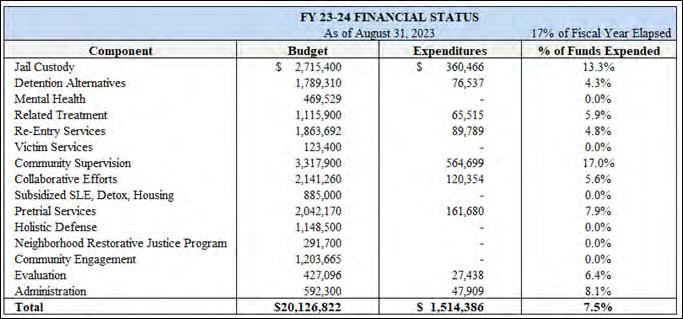
SUPERVISED REALIGNED OFFENDER POPULATION -12 MONTHS 261 258 262 271 264 258 238 253 254 260 268 277 270 133 141 143 147 147 154 152 157 152 154 154 154 164 0 50 100 150 200 250 300 350 400 450 PRCS PSS
Total Sentenced 73
74 *PRCS/PSS 52 0 52 *Parole
0 0
Bed Days % of Planned Bed Days Custody 2542 75.97% Alternative 31 0.93% Total 2573 76.90%
Alternative
1
0
# of PRCS Entered Exited Net 18 2 280 # of PSS (NX3) Entered Exited Net
158 COURTS # of NX3 Sentences This Month Last Month Custody only 2 5 PSS 7 7 # of Individuals with Signed Waivers This Month 0 Last Month 0 # of PRCS Revocation Hearings This Month 2 Last Month 1 116 95 59 PRCS Offenders by Region Santa
Lompoc 73 67 20 PSS Offenders by Region Santa Maria Santa Barbara Lompoc 90% 9% PRCS by Gender Male Female 81% 19% PSS by Gender Male Female # of offenders Attachment #1 69
3 8
Maria Santa Barbara
PROBATION
Realignment Operational Impact Report September 2023
SHERIFF
Incarcerated Realigned Offenders Custody Alternative
*Technical Violations Only Total Planned Bed Days: 3346/Month (110 ADA)
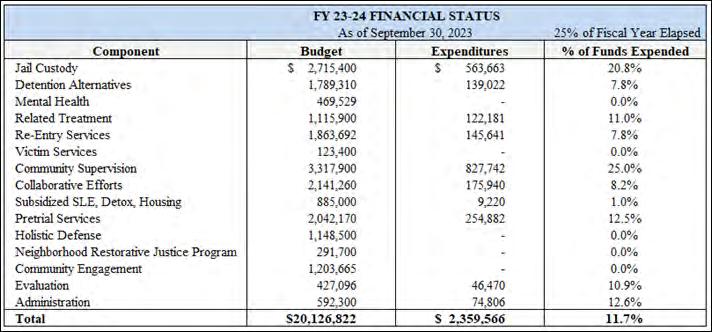
SUPERVISED REALIGNED OFFENDER POPULATION -12 MONTHS 258 262 271 264 258 238 253 254 260 268 277 270 281 141 143 147 147 154 152 157 152 154 154 154 164 162 0 50 100 150 200 250 300 350 400 450 PRCS PSS
Total Sentenced 74
75 *PRCS/PSS 45 0 45 *Parole
0 0
Bed Days % of Planned Bed Days Custody 2289 68.41% Alternative 30 0.90% Total 2319 69.31%
1
0
# of PRCS Entered Exited Net
269 # of PSS (NX3)
COURTS # of NX3 Sentences This Month Last Month Custody only 6 2 PSS 4 7 # of Individuals with Signed Waivers This Month 0 Last Month 0 # of PRCS Revocation Hearings This Month 0 Last Month 0 115 94 60 PRCS Offenders by Region Santa Maria Santa Barbara Lompoc 76 69 25 PSS Offenders by Region Santa Maria Santa Barbara Lompoc 91% 9% PRCS by Gender Male Female 79% 21% PSS by Gender Male Female # of offenders 70 Attachment #1
3 1
Entered Exited Net 12 7 170
PROBATION
Realignment Operational Impact Report
October 2023
SHERIFF
Incarcerated Realigned Offenders Custody
*Technical Violations Only Total Planned Bed Days: 3346/Month (110 ADA)

SUPERVISED REALIGNED OFFENDER POPULATION -12 MONTHS 262 271 264 258 238 253 254 260 268 277 270 281 276 143 147 147 154 152 157 152 154 154 154 164 162 166 0 50 100 150 200 250 300 350 400 450 PRCS PSS
Sentenced 73
76 *PRCS/PSS 56 0 56 *Parole
0 0
Bed Days % of Planned Bed Days Custody 2577 77.02% Alternative 90 2.69% Total 2667 79.71%
Alternative Total
3
0
# of PRCS Entered Exited Net
276 # of PSS (NX3) Entered
COURTS # of NX3 Sentences This Month Last Month Custody only 3 6 PSS 3 4 # of Individuals with Signed Waivers This Month 0 Last Month 0 # of PRCS Revocation Hearings This Month 0 Last Month 0 109 97 61 PRCS Offenders by Region Santa Maria Santa Barbara Lompoc 77 70 26 PSS Offenders by Region Santa Maria Santa Barbara Lompoc 91% 9% PRCS by Gender Male Female 79% 21% PSS by Gender Male Female # of offenders Attachment #1 71
5 12
Exited Net 12 2 166
PROBATION
Realignment Operational Impact Report
SHERIFF
Incarcerated Realigned Offenders Custody Alternative
*Technical Violations Only
Planned Bed Days: 3346/Month (110 ADA)

SUPERVISED REALIGNED OFFENDER POPULATION -12 MONTHS 271 264 258 238 253 254 260 268 277 270 281 276 293 147 147 154 152 157 152 154 154 154 164 162 166 165 0 50 100 150 200 250 300 350 400 450 PRCS PSS
November 2023
Sentenced
69 *PRCS/PSS
0 41 *Parole
0 0
Bed Days % of Planned Bed Days Custody 2478 74.06% Alternative 78 2.33% Total 2556 76.39%
Total
66 3
41
0
Total
# of PRCS Entered Exited Net 21 5 293 # of PSS (NX3) Entered Exited Net 3
165 COURTS # of NX3 Sentences This Month Last Month Custody only 2 3 PSS 3 3 # of Individuals with Signed Waivers This Month 0 Last Month 0 # of PRCS Revocation Hearings This Month 0 Last Month 0 118 97 65 PRCS Offenders by Region Santa Maria Santa Barbara Lompoc 74 70 26 PSS Offenders by Region Santa Maria Santa Barbara Lompoc 92% 8% PRCS by Gender Male Female 78% 22% PSS by Gender Male Female # of offenders 72 Attachment #1
4
PROBATION
Realignment Operational Impact Report December 2023
SHERIFF
Incarcerated Realigned Offenders Custody Alternative
Violations Only
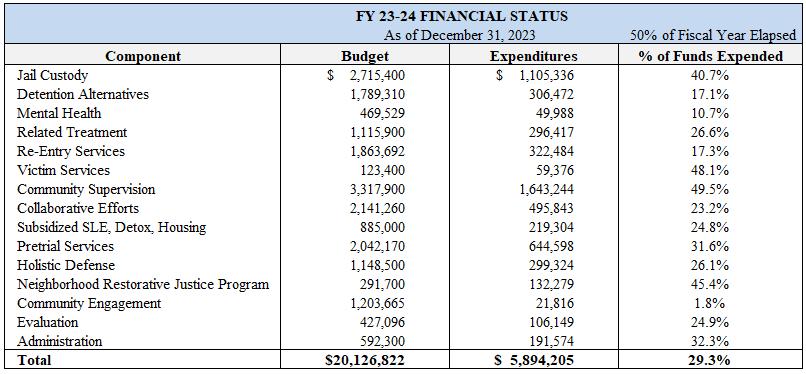
SUPERVISED REALIGNED OFFENDER POPULATION -12 MONTHS 264 258 238 253 254 260 268 277 270 281 276 293 299 147 154 152 157 152 154 154 154 164 162 166 165 158 0 50 100 150 200 250 300 350 400 450 PRCS PSS
Sentenced
69 *PRCS/PSS 41 0 41 *Parole
0 0
Bed Days % of Planned Bed Days Custody 2478 74.06% Alternative 78 2.33% Total 2556 76.39%
Total
66 3
0
*Technical
Total Planned Bed Days: 3346/Month (110 ADA)
# of PRCS Entered Exited Net 14 4 299 # of PSS (NX3) Entered Exited Net 6 4 158 COURTS # of NX3 Sentences This Month Last Month Custody only 5 2 PSS 2 3 # of Individuals with Signed Waivers This Month 0 Last Month 0 # of PRCS Revocation Hearings This Month 2 Last Month 0 121 99 69 PRCS Offenders by Region Santa Maria Santa Barbara Lompoc 74 65 25 PSS Offenders by Region Santa Maria Santa Barbara Lompoc 91% 9% PRCS by Gender Male Female 77% 23% PSS by Gender Male Female # of offenders Attachment #1 73
RealignmentOperationalImpactReport
SHERIFF
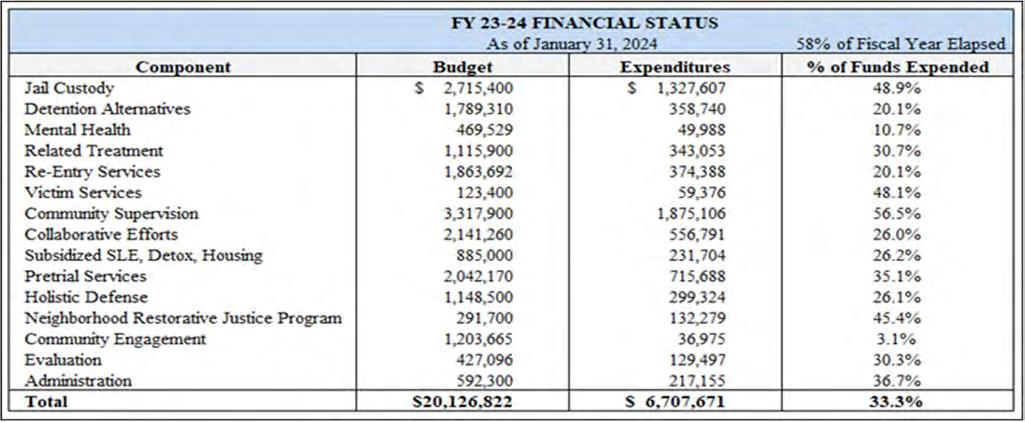
SUPERVISEDREALIGNEDOFFENDERPOPULATION-12MONTHS 258238253254260268277270281276293299297 154152157152154154154164162166165158170 0 50 100 150 200 250 300 350 400 450 PRCS PSS
January
2024
IncarceratedRealignedOffenders Custody Alternative Total Sentenced 66 6 72 *PRCS/PSS 55 0 55 *Parole 0 0 0 *Technical Violations Only TotalPlannedBedDays: 3346/Month (110ADA) Bed Days %ofPlanned BedDays Custody 2280 68.14% Alternative 186 5.56% Total 2466 73.70%
#ofPRCS Entered Exited Net 21 5 309 #ofPSS(NX3) Entered Exited Net 14 1 163 COURTS #ofNX3Sentences This Month Last Month Custodyonly 8 5 PSS 5 2 #ofIndividualswithSignedWaivers ThisMonth 0 LastMonth 0 #ofPRCSRevocationHearings ThisMonth 2 LastMonth 2 129 98 70 PRCSOffenders byRegion Santa Maria Santa Barbara Lompoc 78 66 26 PSSOffenders byRegion Santa Maria Santa Barbara Lompoc 90% 10% PRCS byGender Male Female 78% 22% PSS byGender Male Female # of offenders 74
PROBATION

Substance Abuse
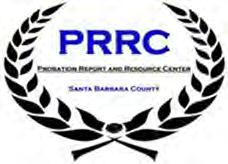
Moral Reconation Therapy (MRT) is an evidence-based, cognitive behavioral treatment program focused on substance abuse that targets recidivism reduction, and is designed to facilitate the development of higher stages of moral reasoning. Classes are available for realigned and medium –high risk felony clients. When there are three or more female clients, there will be one femaleonly group. Consists of twice weekly 90-minute sessions for three groups of up to 12 realigned clients, and twice weekly 90-minute sessions for two groups of up to 12 medium – high risk felony clients.
Recovery Oriented System of Care (ROSC) is a secular, peer-driven support group for clients with substanceabuse issues, and similarto a 12 Step program. Support groups are available for medium and high-risk offenders and consist of twice-weekly sessions of 60-90 minutes.
Sanctuary Centers of Santa Barbara provides enhanced outpatient treatment services and related recovery and re-entry services for a dual diagnosis population of Realigned offenders, specifically Post-Release CommunitySupervision (PRCS), Post-Sentence Supervision (PSS) and/or clientsunder standard supervision at the Santa Barbara PRRC. Services include a risk and need assessment, individual counseling and/or group counseling, and a continuum of care for those located in South Countyuponre-entry tothe community from incarceration.The risk assessment tools used include the Mental Health Screening Form (MHSF) and the Drug Abuse Screening Test (DAST).
Employment
Work and Gain Economic $elf $ufficiency (WAGE$$) is designed to assist unemployed or underemployed clients. Participants will learn job-seeking skills and interview techniques with a focus on how to answer questions regarding criminal conviction(s) in both the application and interview process. Clients will have an opportunity to improve their interviewing skills, learn what to wear for job interviews, and where to look for employment. Each participant is required to complete a resume. Classes are available for both realigned and medium – high risk offenders.
ServSafe Food Handlers Certification: All persons handling food are required by the State of California to possess a Food Handlers Certification Card. To aid clients in obtaining employment in the food service and hospitality industry, a Food Handlers Certification card will be provided upon successful completion of instruction. Instruction available upon request.
Drop-in Employment: Clients can utilize computers for online job searches, check posted classifieds and get assistance completing and sending job applications and resumes. Assistance with completing application forms such as SSI, CDL/CA ID forms is also available.
Attachment #2
75
SANTA BARBARA PRRC PROGRAM GUIDE
Trauma Informed Care
Seeking Safety is a gender specific, evidence-based recovery support service for clients with a historyof trauma and/or substance abuse. Classes are available for realigned clients only. Consists of one weekly 60-90-minute session for a group of 12-15 clients.
Case Management
Courage toChange Interactive Journaling® System is an evidenced-basedcase management model developed in collaboration with several US Probation offices. Through the use of this cognitivebehavioral Interactive Journaling® System and interaction with their support team, clients address their individual problem areas based on a criminogenic risk and needs assessment.
CognitiveBehavior Therapy
Reasoning and Rehabilitation (R&R) is an evidence-based cognitive behavioral program designed to teachimpulse control,problem solving techniques and systematic thinking with a movetowards more empathetic behavior in a social environment. Classes are available for realigned and medium – high risk felony clients, and consist of 1.5 to 2-hoursessions, twice per week for a period of 7 weeks, closed groups of 10-15 clients each.
Housing / Life Skills / Education
AmeriCorps: Clients at-risk or experiencing homelessness are assessed and given assistance in overcoming housing barriers including advocating for or referrals to resources that produce the income required to obtain housing. This ranges from: County Social Services or Federal Social Security; completing applications to CSL homes, the Housing Authority Section 8 voucher program, or rapid re-housing rental assistance; referrals to Goodwill Workforce Services for employment assistance. Additionally, referrals to SEE International for free eye exam and glasses. Assistance in navigating the legal system for dismissal of convictions, felony reduction, or early termination of probation.
Drop-in Education: Clients are given information regarding how to obtain their GED and on Santa Barbara City College (SBCC) enrollment. Participants can utilize computers for SBCC online enrollment and to view class schedules. Clients are encouraged to utilize computers for completing homework and online assignments requiring internet connection. 4500 Hollister Avenue, Santa Barbara, CA 93110 (805) 692-4890
– Thursday 8:30am to 5:30pm, Friday 8:30am to 5:00pm
Attachment #2
76
Monday
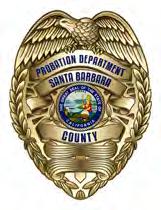
Substance Abuse
SANTA MARIA PRRC PROGRAM GUIDE

Moral Reconation Therapy (MRT) is an evidence-based, cognitive behavioral treatment program focused on substance abuse that targets recidivism reduction, and is designed to facilitate the development of higher stages of moral reasoning. Classes are available for realigned and medium –high risk felony clients. When there are three or more female clients, there will be one femaleonly group. Consists of twice weekly 90-minute sessions for three groups of up to 12 realigned clients, and twice weekly 90-minute sessions for two groups of up to 12 medium – high risk felony clients.
Recovery Oriented System of Care (ROSC) is a secular, peer-driven support group for clients with substanceabuse issues, and similarto a 12 Step program. Support groups are available for medium and high-risk offenders and consist of twice-weekly sessions of 60-90 minutes.
Reset is designed to address a drug or alcohol relapse for clients who are currently enrolled in or have successfully completed MRT and uses Living in Balance, an evidence-based curriculum. Using a multi-disciplinary team approach, each track is developed by the PRRC Senior Deputy Probation Officer (SrDPO), PRRC DPO, treatment provider manager, and treatment provider counselor based on the client’s specific needs and situation.
Employment
Work and Gain Economic $elf $ufficiency (WAGE$$) is designed to assist unemployed or underemployed clients. Participants will learn job-seeking skills and interview techniques with a focus on how to answer questions regarding criminal conviction(s) in both the application and interview process. Clients will have an opportunity to improve their interviewing skills, learn what to wear for job interviews, and where to look for employment. Each participant is required to complete a resume. Classes are available for both realigned and medium – high risk offenders.
ServSafe Food Handlers Certification: All persons handling food are required by the State of California to possess a Food Handlers Certification Card. To aid clients in obtaining employment in the food service and hospitality industry, a Food Handlers Certification card will be provided upon successful completion of instruction. Instruction available upon request.
Drop-in Employment: Clients can utilize computers for online job searches, check posted classifieds and get assistance completing and sending job applications and resumes. Assistance with completing application forms such as SSI, CDL/CA ID forms is also available.
Attachment #2
77
Trauma Informed Care
Seeking Safety is a gender specific, evidence-based recovery support service for clients with a historyof trauma and/or substance abuse. Classes are available for realigned clients only. Consists of one weekly 60-90-minute session for a group of 12-15 clients.
Case Management
Courage toChange Interactive Journaling® System is an evidenced-basedcase management model developed in collaboration with several US Probation offices. Through the use of this cognitivebehavioral Interactive Journaling® System and interaction with their support team, clients address their individual problem areas based on a criminogenic risk and needs assessment.
CognitiveBehavior Therapy
Reasoning and Rehabilitation (R&R) is an evidence-based cognitive behavioral program designed to teachimpulse control,problem solving techniques and systematic thinking with a movetowards more empathetic behavior in a social environment. Classes are available for realigned and medium – high risk felony clients, and consist of 1.5 to 2-hoursessions, twice per week for a period of 7 weeks, closed groups of 10-15 clients each.
Housing / Life Skills / Education
AmeriCorps: Clients at-risk or experiencing homelessness are assessed and given assistance in overcoming housing barriers including advocating for or referrals to resources that produce the income required to obtain housing. This ranges from: County Social Services or Federal Social Security; completing applications to CSL homes, the Housing Authority Section 8 voucher program, Coast Valley deposit assistance, City of Lompoc deposit assistance, or rapid re-housing rental assistance. Additionally, referrals to Allen Hancock College BIGE Club for continued education/skill training; SEE International for free eye exam and glasses. Assistance in navigating the legal system for dismissal of convictions, felony reduction, or early termination of probation.
Drop-in Education: Clients get information on obtaining their GED and Allan Hancock College enrollment. Participants can utilize computers for Hancock College online enrollment and to view class schedules. One-on-one tutoring is also available to clients who desire additional assistance with course work, reading and writing skills, English, computer skills, etc. Clients are assessed by certified teaching staff and a tutor assigned based on the client’s needs. Available Monday thru Friday during program hours
Batterer’s Intervention Program
Sessions are targeted to increase responsibility for the domestic violence act by the client, gain awareness on how the client’s behavior impacts the entire family, and increase empathy for the victim(s) of the violence. Sessions are once a week for two hours, for 26 weeks.
Monday – Thursday 8:30am to 5:30pm, Friday 8:30am to 5:00 pm
Attachment #2
Carmen Lane, Suite K, Santa Maria, CA 93458
124 W.
78

Sheriff’s Treatment Program (STP) Curriculum Guide
Aggression Replacement Training (ART)
This curriculum uses a cognitive behavioral approach to help participants better manage their anger and reduce aggressive behavior. ART is divided into three main components which are the following Social Skills Training (the behavioral component), Angel Control Training (the affective component), and Moral Reasoning (the cognitive component). Participants practice strategies to change anti-social attitudes and behaviors, reduce anti-social peer associations, increase selfcontrol, and develop problem solving skills in healthy ways.
Cognitive Behavioral Interventions for Offenders Seeking Employment (CBI-EMP)
CBI-EMP is designed for individuals who have difficulties obtaining and maintaining employment. This intervention relies on a cognitive behavioral approach to teach participants strategies for identifying and managing high risk situations at work, focusing specifically on how thoughts, attitudes, values, and beliefs drive behavior. Participants will engage in many skill building activities, such as role play, as a part of the therapeutic process and will spend a significant amount of time in the group learning and practicing new methods of handling risky situations that might occur while at work. CBI-EMP is divided into three components which includes identifying and restructuring risky thinking, learning new skills/behaviors, and problem solving to increase success and goal achievement in the workplace.
Thinking for a Change (T4C)
T4C uses a cognitive behavioral approach to assist participants in changing criminogenic thinking patterns. Thinking for a Change is formulated of three components which are: cognitive selfchange, social skills, and problem-solving skills. The cognitive self-change component teaches individuals a concrete process for self-reflection aimed at uncovering antisocial thoughts, feelings, attitudes, and beliefs. The social skills instruction prepares group members to engage in pro-social interactions based on self-understanding and consideration of their impact of their actions on others. The problem-solving skills component integrates the two previous interventions to provide group members with a detailed step-by-step process for addressing challenging and stressful situations.
Attachment #3 79
Moral Reconation Therapy (MRT)
MRT is a cognitive-behavioral treatment strategy designed to enhance self-image, promote growth of a positive, productive identity, and to facilitate the development of higher stages of moral reasoning. The term moral reconation was chosen for this curriculum because first, before the term "ego" came into psychology in the 1930s, the term "conation" was used.
Reasoning & Rehabilitation (R&R)
The R&R program is a multifaceted, cognitive-behavioral program designed to teach cognitive skills and values essential for prosocial competence. The program enables participants to increase impulse-control, meta-cognition, critical thinking, and social/interpersonal skills.
Alcohol and Other Drug Education (AOD)
Created in partnership with the Minnesota Department of Corrections, A New Direction Alcohol and Other Drug Education is a flexible, evidence-based, cognitive-behavioral therapy (CBT) curriculum that treats addiction in justice-involved clients and is proven to reduce recidivism. Justice-involved clients learn that substance use disorder is a chronic disease and recognize the negative effects addiction has on the body and all aspects of life. Clients learn they can choose to change and live freely in recovery. This workbook includes Quick Review exercises to reinforce lessons, reflection exercises that bridge content with real-life experience, and Thinking Reports to ensure treatment methods are part of ongoing aftercare.
The Courage to Change Interactive Journaling System (C2C)
The Courage to Change Interactive Journaling® System is an evidence-based supervision/case management model developed in collaboration with several United States Probation Offices. Through the use of this cognitive behavioral Interactive Journaling® System and interaction with their support team, participants address their individual problem areas based on a criminogenic risk and needs assessment. Implementation is flexible and can be customized based on risk, responsivity, and programming needs. By personalizing the information presented in the Journals to their own circumstances, participants will develop a record of their commitments and progress throughout probation and a roadmap to success in their efforts to make positive behavior change. Journal topics include Getting Started, Social Values, Responsible Thinking, Self-Control, Peer Relationships, Family Ties, Substance Use, Seeking Employment and Recreation & Leisure.
Attachment #3 80
COUNTYOFSANTABARBARA








COMMUNITYCORRECTIONSPARTNERSHIP www.sbprobation.org







































































































































































































